《电化学基础》单元测试题.doc
- 格式:doc
- 大小:182.50 KB
- 文档页数:6
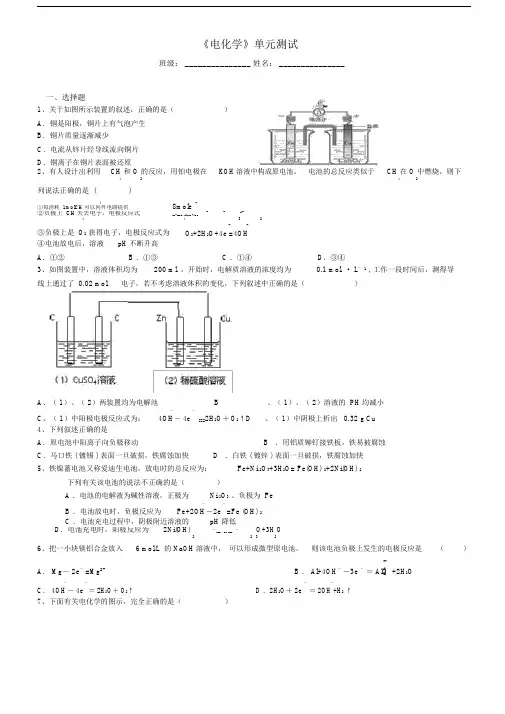
《电化学》单元测试班级: _______________ 姓名: _______________一、选择题1、关于如图所示装置的叙述,正确的是( )A .铜是阳极,铜片上有气泡产生B .铜片质量逐渐减少C .电流从锌片经导线流向铜片D .铜离子在铜片表面被还原2、有人设计出利用 CH 和 O 的反应,用铂电极在KOH 溶液中构成原电池。
电池的总反应类似于CH 在 O 中燃烧,则下4242列说法正确的是 ()48mole -①每消耗 1molCH 可以向外电路提供②负极上 CH 失去电子,电极反应式--2-CH+10OH -8e =CO +7H O443 2③负极上是 O 2 获得电子,电极反应式为 --O 2+2H 2O+4e =4OH④电池放电后,溶液 pH 不断升高A .①②B .①③C .①④D .③④3、如图装置中,溶液体积均为 200 ml ,开始时,电解质溶液的浓度均为 0.1 mol · L - 1 , 工作一段时间后,测得导线上通过了 0.02 mol电子,若不考虑溶液体积的变化,下列叙述中正确的是()A 、( 1)、( 2)两装置均为电解池B、( 1)、( 2)溶液的 PH 均减小C 、( 1)中阳极电极反应式为: -- 4e -===2H 2O + O 2↑D、( 1)中阴极上析出 0.32 g Cu4OH4、下列叙述正确的是A .原电池中阳离子向负极移动B .用铝质铆钉接铁板,铁易被腐蚀C .马口铁 ( 镀锡 ) 表面一旦破损,铁腐蚀加快D .白铁 ( 镀锌 ) 表面一旦破损,铁腐蚀加快5、铁镍蓄电池又称爱迪生电池,放电时的总反应为:Fe+Ni 2O 3+3H 2O= Fe(OH) 2+2Ni(OH) 2下列有关该电池的说法不正确的是( )A .电池的电解液为碱性溶液,正极为Ni 2O 3 、负极为 FeB .电池放电时,负极反应为――2e -=Fe (OH) 2Fe+2OHC .电池充电过程中,阴极附近溶液的 pH 降低D .电池充电时,阳极反应为 2Ni(OH) - - O+3H O2 +2OH - 2e =Ni23 26、把一小块镁铝合金放入 6 mol/L 的 NaOH 溶液中, 可以形成微型原电池。
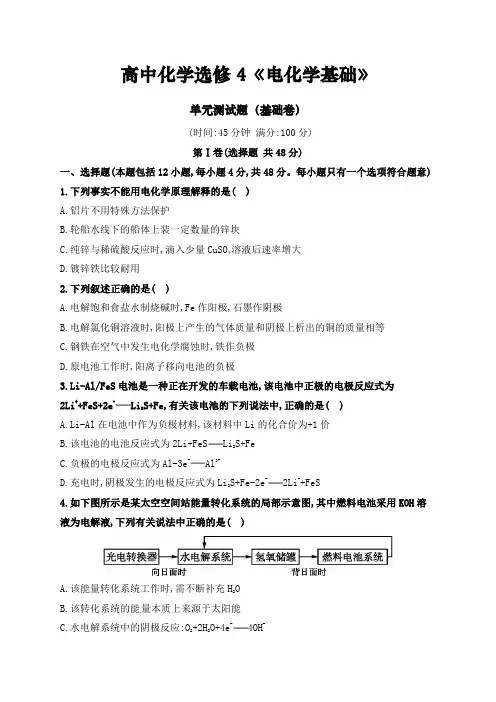
高中化学选修4《电化学基础》单元测试题(基础卷)(时间:45分钟满分:100分)第Ⅰ卷(选择题共48分)一、选择题(本题包括12小题,每小题4分,共48分。
每小题只有一个选项符合题意)1.下列事实不能用电化学原理解释的是( )A.铝片不用特殊方法保护B.轮船水线下的船体上装一定数量的锌块C.纯锌与稀硫酸反应时,滴入少量CuSO4溶液后速率增大D.镀锌铁比较耐用2.下列叙述正确的是( )A.电解饱和食盐水制烧碱时,Fe作阳极,石墨作阴极B.电解氯化铜溶液时,阳极上产生的气体质量和阴极上析出的铜的质量相等C.钢铁在空气中发生电化学腐蚀时,铁作负极D.原电池工作时,阳离子移向电池的负极3.Li-Al/FeS电池是一种正在开发的车载电池,该电池中正极的电极反应式为2Li++FeS+2e-Li2S+Fe,有关该电池的下列说法中,正确的是( )A.Li-Al在电池中作为负极材料,该材料中Li的化合价为+1价B.该电池的电池反应式为2Li+FeS Li2S+FeC.负极的电极反应式为Al-3e-Al3+D.充电时,阴极发生的电极反应式为Li2S+Fe-2e-2Li++FeS4.如下图所示是某太空空间站能量转化系统的局部示意图,其中燃料电池采用KOH溶液为电解液,下列有关说法中正确的是( )A.该能量转化系统工作时,需不断补充H2OB.该转化系统的能量本质上来源于太阳能C.水电解系统中的阴极反应:O2+2H2O+4e-4OH-D.燃料电池放电时的负极反应:H2-2e-2H+5.按下图装置实验,若x轴表示流入阴极的电子的物质的量,则y轴可表示( )①c(Ag+) ②c(AgNO3) ③a棒的质量④b棒的质量⑤溶液的pHA.①③B.③④C.①②④D.①②⑤6.Mg-H2O2电池可用于驱动无人驾驶的潜航器。
该电池以海水为电解质溶液,示意图如下。
该电池工作时,下列说法正确的是( )A.Mg电极是该电池的正极B.H2O2在石墨电极上发生氧化反应C.石墨电极附近溶液的pH增大D.溶液中Cl-向正极移动7.铅蓄电池的工作原理为Pb+PbO2+2H2SO42PbSO4+2H2O,研读下图,下列判断不正确的是( )A.K闭合时,d电极反应式:PbSO4+2H2O-2e-PbO2+4H++SB.当电路中转移0.2 mol电子时,Ⅰ中消耗的H2SO4为0.2 molC.K闭合时,Ⅱ中S向c电极迁移D.K闭合一段时间后断开,Ⅱ可单独作为原电池,d电极为正极8.用酸性氢氧燃料电池电解苦卤水(含Cl-、Br-、Na+、Mg2+)的装置如图所示(a、b为石墨电极)。
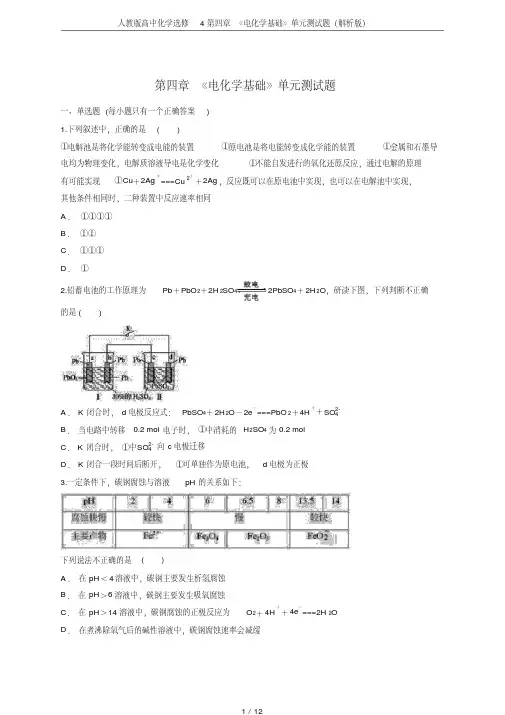
第四章《电化学基础》单元测试题一、单选题(每小题只有一个正确答案)1.下列叙述中,正确的是()①电解池是将化学能转变成电能的装置①原电池是将电能转变成化学能的装置①金属和石墨导电均为物理变化,电解质溶液导电是化学变化①不能自发进行的氧化还原反应,通过电解的原理有可能实现①Cu+2Ag+===Cu2++2Ag,反应既可以在原电池中实现,也可以在电解池中实现,其他条件相同时,二种装置中反应速率相同A.①①①①B.①①C.①①①D.①2.铅蓄电池的工作原理为Pb+PbO2+2H2SO42PbSO4+2H2O,研读下图,下列判断不正确的是()A. K闭合时,d电极反应式:PbSO4+2H2O-2e-===PbO2+4H++SO42-B.当电路中转移0.2 mol电子时,①中消耗的H2SO4为0.2 molC. K闭合时,①中SO42-向c电极迁移D. K闭合一段时间后断开,①可单独作为原电池,d电极为正极3.一定条件下,碳钢腐蚀与溶液pH的关系如下:下列说法不正确的是()A.在pH<4溶液中,碳钢主要发生析氢腐蚀B.在pH>6溶液中,碳钢主要发生吸氧腐蚀C.在pH>14溶液中,碳钢腐蚀的正极反应为O2+4H++4e-===2H2OD.在煮沸除氧气后的碱性溶液中,碳钢腐蚀速率会减缓4.锌溴液流电池是一种新型电化学储能装置(如图所示),电解液为溴化锌水溶液,电解液在电解质储罐和电池间不断循环。
下列说法不正确的是()A.充电时电极a连接电源的负极B.放电时负极的电极反应式为Zn—2e-===Zn2+C.放电时左侧电解质储罐中的离子总浓度增大D.阳离子交换膜可阻止Br2与Zn直接发生反应5.下图为铜锌原电池示意图,下列说法正确的是()A.锌片逐渐溶解B.烧杯中溶液逐渐呈蓝色C.电子由铜片通过导线流向锌片D.锌为正极,铜为负极6.下列关于金属的防护方法的说法不正确的是()A.我们使用的快餐杯表面有一层搪瓷,搪瓷层破损后仍能起到防止铁生锈的作用B.给铁件通入直流电,把铁件与电池负极相连接C.轮船在船壳水线以下常装有一些锌块,这是利用了牺牲阳极的阴极保护法D.钢铁制造的暖气管管道外常涂有一层较厚的沥青7.锌铜原电池装置如图所示,其中阳离子交换膜只允许阳离子和水分子通过,下列有关叙述正确的是()A.铜电极上发生氧化反应B.电池工作一段时间后,甲池的c(SO42-)减小C.电池工作一段时间后,乙池溶液的总质量增加D.阴、阳离子分别通过交换膜向负极和正极移动,保持溶液中电荷平衡8.用惰性电极电解一定浓度的CuSO4溶液时,通电一段时间后,向所得的溶液中加入0.1 mol Cu2(OH)2CO3后恰好恢复到电解前的浓度和pH (不考虑二氧化碳的溶解)。
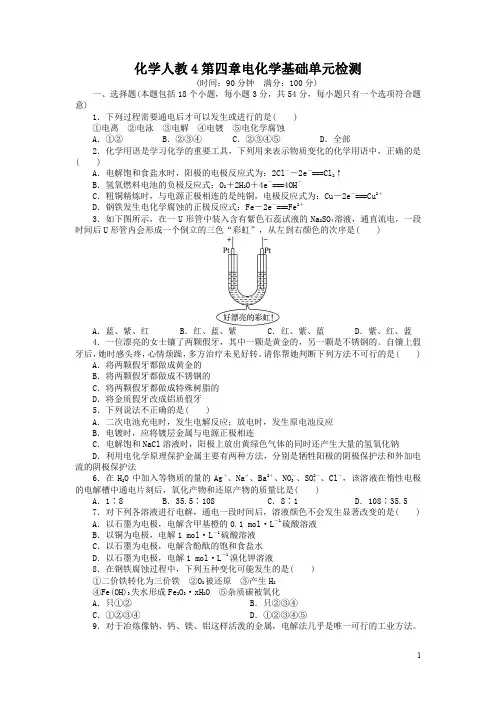
化学人教4第四章电化学基础单元检测(时间:90分钟满分:100分)一、选择题(本题包括18个小题,每小题3分,共54分,每小题只有一个选项符合题意)1.下列过程需要通电后才可以发生或进行的是( )①电离②电泳③电解④电镀⑤电化学腐蚀A.①② B.②③④ C.②③④⑤ D.全部2.化学用语是学习化学的重要工具,下列用来表示物质变化的化学用语中,正确的是( )A.电解饱和食盐水时,阳极的电极反应式为:2Cl--2e-===Cl2↑B.氢氧燃料电池的负极反应式:O2+2H2O+4e-===4OH-C.粗铜精炼时,与电源正极相连的是纯铜,电极反应式为:Cu-2e-===Cu2+D.钢铁发生电化学腐蚀的正极反应式:Fe-2e-===Fe2+3.如下图所示,在一U形管中装入含有紫色石蕊试液的Na2SO4溶液,通直流电,一段时间后U形管内会形成一个倒立的三色“彩虹”,从左到右颜色的次序是( )A.蓝、紫、红B.红、蓝、紫C.红、紫、蓝D.紫、红、蓝4.一位漂亮的女士镶了两颗假牙,其中一颗是黄金的,另一颗是不锈钢的。
自镶上假牙后,她时感头疼,心情烦躁,多方治疗未见好转。
请你帮她判断下列方法不可行的是( ) A.将两颗假牙都做成黄金的B.将两颗假牙都做成不锈钢的C.将两颗假牙都做成特殊树脂的D.将金质假牙改成铝质假牙5.下列说法不正确的是( )A.二次电池充电时,发生电解反应;放电时,发生原电池反应B.电镀时,应将镀层金属与电源正极相连C.电解饱和NaCl溶液时,阳极上放出黄绿色气体的同时还产生大量的氢氧化钠D.利用电化学原理保护金属主要有两种方法,分别是牺牲阳极的阴极保护法和外加电流的阴极保护法6.在H2O中加入等物质的量的Ag+、Na+、Ba2+、NO-3、SO2-4、Cl-,该溶液在惰性电极的电解槽中通电片刻后,氧化产物和还原产物的质量比是( )A.1∶8 B.35.5∶108C.8∶1 D.108∶35.57.对下列各溶液进行电解,通电一段时间后,溶液颜色不会发生显著改变的是( ) A.以石墨为电极,电解含甲基橙的0.1 mol·L-1硫酸溶液B.以铜为电极,电解1 mol·L-1硫酸溶液C.以石墨为电极,电解含酚酞的饱和食盐水D.以石墨为电极,电解1 mol·L-1溴化钾溶液8.在钢铁腐蚀过程中,下列五种变化可能发生的是( )①二价铁转化为三价铁②O2被还原③产生H2④Fe(OH)3失水形成Fe2O3·xH2O ⑤杂质碳被氧化A.只①②B.只②③④C.①②③④D.①②③④⑤9.对于冶炼像钠、钙、镁、铝这样活泼的金属,电解法几乎是唯一可行的工业方法。

高中化学学习材料唐玲出品选修4第四章《电化学基础》单元测试题本试卷分选择题和非选择题两部分,共7页,满分150分,考试用时90分钟。
第一部分 选择题(共90分)一、选择题(本题包括10小题,每小题4分,共40分。
每小题只有一个选项符合题意)1.废电池的污染引起人们的广泛重视,废电池中对环境形成污染的主要物质是A .锌B .汞C .石墨D .二氧化锰 2.镍镉(Ni —Cd )可充电电池在现代生活中有广泛应用,它的充放电反应按下式进行:Cd(OH)2+2Ni(OH)2 Cd+2NiO(OH)+2H 2O由此可知,该电池放电时的负极材料是A .Cd(OH)2B .Ni(OH)2C .CdD .NiO(OH)3.将纯锌片和纯铜片按图示方式插入同浓度的稀硫酸中一段时间,以下叙述正确的是 A .两烧杯中铜片表面均无气泡产生 B .甲中铜片是正极,乙中铜片是负极 C .两烧杯中溶液的pH 均增大 D .产生气泡的速度甲比乙慢4.下列各变化中属于原电池反应的是A .在空气中金属铝表面迅速氧化形成保护层B .镀锌铁表面有划损时,也能阻止铁被氧化C .红热的铁丝与冷水接触,表面形成蓝黑色保护层D .浓硝酸比稀硝酸更能氧化金属铜5.钢铁发生吸氧腐蚀时,正极上发生的电极反应是A. 2H ++2e -=H 2 B. Fe 2++2e -=Fe B. 2H 2O +O 2+4e -=4OH -D. Fe 3++e -=Fe 2+6.已知蓄电池在充电时作电解池,放电时作原电池。
铅蓄电池上有两个接线柱,一个接线柱旁标有“+”,另一个接线柱旁标有“—”。
关于标有“+”的接线柱,下列说法中正确..的是 充电 放电A.充电时作阳极,放电时作负极 B.充电时作阳极,放电时作正极C.充电时作阴极,放电时作负极 D.充电时作阴极,放电时作正极7.pH=a的某电解质溶液中,插入两支惰性电极通直流电一段时间后,溶液的pH >a,则该电解质可能是A.NaOH B.H2SO4 C.AgNO3 D.Na2SO48.下列关于实验现象的描述不正确...的是A.把铜片和铁片紧靠在一起浸入稀硫酸中,铜片表面出现气泡B.用锌片做阳极,铁片做阴极,电解氯化锌溶液,铁片表面出现一层锌C.把铜片插入三氯化铁溶液中,在铜片表面出现一层铁D.把锌粒放入盛有盐酸的试管中,加入几滴氯化铜溶液,气泡放出速率加快9.把分别盛有熔融的氯化钾、氯化镁、氯化铝的三个电解槽串联,在一定条件下通电一段时间后,析出钾、镁、铝的物质的量之比为A.1︰2︰3 B.3︰2︰1C.6︰3︰1 D.6︰3︰210.下列描述中,不符合生产实际的是A.电解熔融的氧化铝制取金属铝,用铁作阳极B.电解法精炼粗铜,用纯铜作阴极C.电解饱和食盐水制烧碱,用涂镍碳钢网作阴极D.在镀件上电镀锌,用锌作阳极二.选择题(本题包括10小题,每小题5分,共50分。
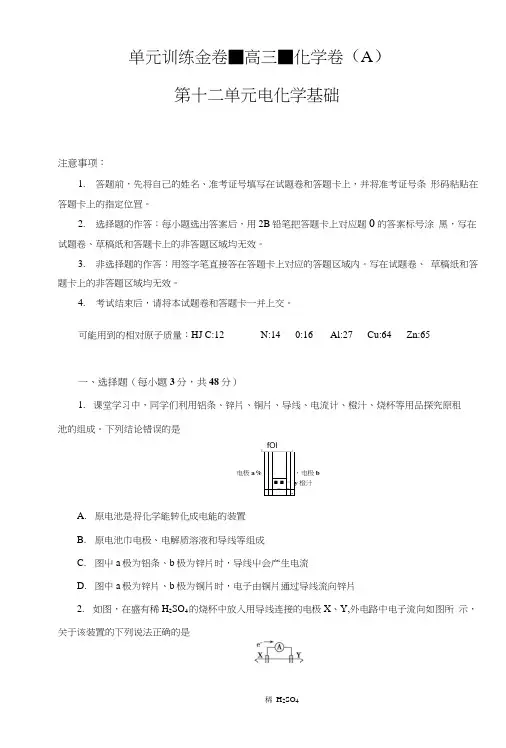
单元训练金卷■高三■化学卷(A )第十二单元电化学基础注意事项:1. 答题前,先将自己的姓名、准考证号填写在试题卷和答题卡上,并将准考证号条 形码粘贴在答题卡上的指定位罝。
2. 选择题的作答:每小题选出答案后,用2B 铅笔把答题卡上对应题0的答案标号涂 黑,写在试题卷、草稿纸和答题卡上的非答题区域均无效。
3. 非选择题的作答:用签字笔直接答在答题卡上对应的答题区域内。
写在试题卷、 草稿纸和答题卡上的非答题区域均无效。
4. 考试结束后,请将本试题卷和答题卡一并上交。
可能用到的相对原子质量:HJ C:12 N:14 0:16 Al:27 Cu:64 Zn:65一、选择题(每小题3分,共48分)1. 课堂学习中,同学们利用铝条、锌片、铜片、导线、电流计、橙汁、烧杯等用品探究原租 池的组成。
下列结论错误的是A. 原电池是将化学能转化成电能的装置B. 原电池巾电极、电解质溶液和导线等组成C. 图屮a 极为铝条、b 极为锌片时,导线屮会产生电流D. 图中a 极为锌片、b 极为铜片时,电子由铜片通过导线流向锌片2. 如图,在盛有稀H 2SO 4的烧杯中放入用导线连接的电极X 、Y,外电路中电子流向如图所 示,关于该装置的下列说法正确的是稀 H 2SO 4 fOlT — ---- ------------- --- —) 电极a%,电极b■ ■ ■ —*y 橙汁 -A.外电路的电流方向为X->外电路一>YB.若两电极分别为铁和碳棒,则X为碳棒,Y为铁C.X极上发生的是还原反应,Y极上发生的是氧化反应D.若两电极都是金属,则它们的活动性强弱为X〉Y3.下列有关电化学装賈完全正确的是4.烧杯A中盛放0.1 mol/L的H2SO4溶液,烧杯B中盛放0.1 mol/L的CuCl2溶液(两种溶液均足量),组成的装置如图所示。
下列说法不正确的是■ MB .•• •» •• •» •稀硫酸氯化铜溶液A BA.A为原电池,B为电解池B.A为电解池,B力原电池C.当A烧杯屮产生0.1 mol气体时,B烧杯中产生气体的物质的呈也为0.1 molD.经过一段时间,B烧杯中溶液溶质的浓度减小5.锌空气燃料电池可用作电动车动力电源,电池的电解质溶液为KOH溶液,反应为2Zn +O2+4OH_+2H2O===2Zn(OH)f。
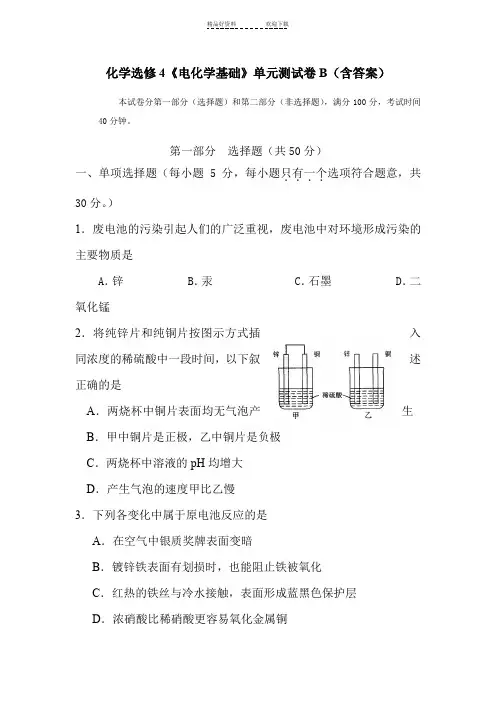
化学选修4《电化学基础》单元测试卷B(含答案)本试卷分第一部分(选择题)和第二部分(非选择题),满分100分,考试时间40分钟。
第一部分选择题(共50分)一、单项选择题(每小题5分,每小题只有一个....选项符合题意,共30分。
)1.废电池的污染引起人们的广泛重视,废电池中对环境形成污染的主要物质是A.锌 B.汞 C.石墨 D.二氧化锰2.将纯锌片和纯铜片按图示方式插入同浓度的稀硫酸中一段时间,以下叙述正确的是A.两烧杯中铜片表面均无气泡产生B.甲中铜片是正极,乙中铜片是负极C.两烧杯中溶液的pH均增大D.产生气泡的速度甲比乙慢3.下列各变化中属于原电池反应的是A.在空气中银质奖牌表面变暗B.镀锌铁表面有划损时,也能阻止铁被氧化C.红热的铁丝与冷水接触,表面形成蓝黑色保护层D.浓硝酸比稀硝酸更容易氧化金属铜4.把分别盛有熔融的氯化钠、氯化镁、氧化铝的三个电解槽串联,在一定条件下通电一段时间后,析出钠、镁、铝的物质的量之比为A .1︰2︰3B .3︰2︰1C .6︰3︰1D .6︰3︰25.关于铅蓄电池Pb +PbO 2+2H 2SO 4 PbSO 4+2H 2O 的说法正确的是A .在放电时,正极发生的反应是 Pb(s) +SO 42—(aq )= PbSO 4(s)+2e —B .在放电时,该电池的负极材料是铅板C .在充电时,电池中硫酸的浓度不断变小D .在充电时,阳极发生的反应是 PbSO 4(s)+2e —= Pb(s)+ SO 42—(aq )6.有一合金由X 、Y 、Z 、W 四种金属组成,若将合金放入盐酸中只有Z 、Y 能溶解;若将合金置于潮湿空气中,表面只出现Z 的化合物;若将该合金做阳极,用X 盐溶液作电解液,通电时四种金属都以离子形式进入溶液中,但在阴极上只析出X 。
这四种金属的活动性顺序是A .Y >Z >W >XB .Z >Y >W >XC .W >Z >Y >XD .X >Y >Z >W放电 充电二、双项选择题(每小题5分,每小题有两个..选项符合题意,错选0分,漏选2分,共20分。
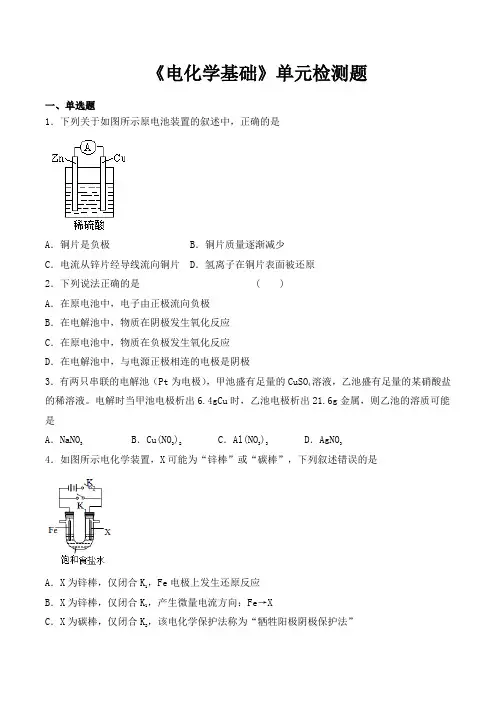
《电化学基础》单元检测题一、单选题1.下列关于如图所示原电池装置的叙述中,正确的是A.铜片是负极 B.铜片质量逐渐减少C.电流从锌片经导线流向铜片 D.氢离子在铜片表面被还原2.下列说法正确的是 ( )A.在原电池中,电子由正极流向负极B.在电解池中,物质在阴极发生氧化反应C.在原电池中,物质在负极发生氧化反应D.在电解池中,与电源正极相连的电极是阴极3.有两只串联的电解池(Pt为电极),甲池盛有足量的CuSO4溶液,乙池盛有足量的某硝酸盐的稀溶液。
电解时当甲池电极析出6.4gCu时,乙池电极析出21.6g金属,则乙池的溶质可能是A.NaNO3B.Cu(NO3)2C.Al(NO3)3D.AgNO34.如图所示电化学装置,X可能为“锌棒”或“碳棒”,下列叙述错误的是A.X为锌棒,仅闭合K1,Fe电极上发生还原反应B.X为锌棒,仅闭合K1,产生微量电流方向:Fe→XC.X为碳棒,仅闭合K2,该电化学保护法称为“牺牲阳极阴极保护法”D.若X为碳棒,仅闭合K1,铁电极的极反应为:Fe -2e-→ Fe2+5.燃料电池的优点是化学能直接转化为电能,而不经过热能这一中间环节,能量利用率高。
氢氧燃料电池可同时供应电和水蒸气,所需燃料为H2,电解质为熔融K2CO3。
已知该电池的正极反应为O2+2CO2+4e-2CO32-。
下列叙述正确的是( )A.放电时CO32-向正极移动B.随着反应的进行,CO32-在不断消耗C.负极反应为H2+CO32--2e-H2O+CO2D.当该电池产生的水蒸气折算成标准状况下的体积为22.4 L时,转移电子4 mol6.如图所示的装置,两烧杯中均为相应的水溶液,通电一段时间后,测得甲池中某电极质量增加2.16g,乙池中某电极上析出0.64g某金属,下列说法正确的是A.甲池是b极上析出金属银,乙池是c极上析出某金属B.甲池是a极上析出金属银,乙池是d极上析出某金属C.某盐溶液可能是CuSO4溶液D.某盐溶液可能是Mg(NO3)2溶液7.下列说法正确的是( )A.实验时酸或碱溅到眼中,应立即用水冲洗,并不断眨眼,不能用手搓揉眼睛B.检验硫酸亚铁铵溶液中Fe2+的方法是:先滴加新制氨水后滴加KSCN溶液C.证明钢铁吸收氧腐蚀的方法是:在镀锌铁皮上滴1~3滴含酚酞的饱和食盐水,静置1~2min,观察现象D.因为氧化铁是一种碱性氧化物,所以常用作红色油漆和涂料8.下列冶炼金属的原理不正确的是()A.电解饱和食盐水制备金属钠B.加热分解Ag2O制备金属银C.Fe2O3与CO高温下反应制备金属铁D.Cu2S与O2高温下反应制备金属铜9.下列各组的电极材料和电解液,不能组成原电池的是A.铜片、铜片、稀硫酸 B.铜片、石墨棒、硝酸银溶液C.锌片、铜片、稀硫酸 D.铜片、银片、FeCl3溶液10.下图中的电化学装置以甲醇(CH3OH)为主要原料合成碳酸二甲酯[(CH3O)2CO],相关说法错误的是A.B是直流电源的负极B.碳酸二甲酯中碳均为+4价C.阳极附近溶液pH降低D.每当有2molH+通过离子交换膜,消耗氧气的体积在标准状况下为11.2L 二、填空题11.某原电池的装置如图所示,看到b极上有红色金属析出,回答下列问题:①若a、b是两种活动性不同的金属,则活动性a____b(填>、<或=);②电路中的电子从____经导线流向_____(填a或b);③溶液中的SO42-向________极移动(填a或b);④若两电极分别是Al和C,则负极的电极反应式为_________________。

《电化学基础》测试卷The electrochemical base test volume(1) basic practiceA,multiple choiceThe following processes need to be electrified to do so: ionization;(2) the electrolysis; (3) plating; (4) electrophoresis; The electrochemical corrosion;A,(1) (2) (3); B, (2) (3) (4); C, (2) (4) (5); D, all;At room temperature, the PH of 0. 1 molar of acid is:A, 1; B, > 1; C, < 1; D, can,t be sure;3, 1 liter contains NaOH under normal temperature of saturated salt water, the PH = 10, with platinum electrodes during electrolysis, when the cathode has a 11. 2 liter gases (standard conditions), the PH of the solution is close to (set after electrolytic solution volume is still 1 liter):A., 0; B, 12; C, 13; D, 14;The basic structure of the newly developed bromine-zinc battery in foreign countries is to use carbon rods as the poles, and the electrolyte is the zinc bromide solution. There are four electrode reactions:N - 2e = Zn = Zn + 2e 二ZnThe anode reaction and discharge when charged are:A, (4) (1); B, (2) (3); C, (3) (1); D, (2) (4);The colbay reaction is 2RC00K + 2H2OR -r + H2 + 2K0H, and the following statement is true (C)The products ofB. the products of hydrogen are produced in the cathode.C. the products of carbon are produced in the anode.D. The products of carbon are produced in the cathode.hydrogen are produced in the anode.Use 0.01 mo/litre H2S04 titrate 0. 01 mo/liter NaOH solution, neutralize and add water to 100m 1. If there is an error in the end, the ratio of 1 drop of H2S04 to 1 drop of H2S04 (1 drop to 0. 05 ml), and the ratio of C (H +) is:A: ten b. fifty c. fiveIn a beaker of saturated sodium carbonate, insert inert electrodes, keep the temperature constant, and after a certain amount of time:The PH of the solution will increaseB.The ratio of sodium ions to carbonate ions will be smallerC.The concentration of the solution gradually increases, and a certain amount of crystal is precipitated outThe concentration of the solution stays the same8, room temperature, the pH = 1 hydrochloride average into 2 portions, 1 add right amount water, the other one to join with the mo1ar concentration of hydrochloric acid after the same amount of NaOH solution, pH is increased by 1, belong to the water and the volume of NaOH solution is as follows:A.10 c. 11 d. 129, there are five bottles of solution are respectively (1) 10 ml of 0. 60 mo/NaOH aqueous solution (2) 20 ml mo / 0. 50 litres of sulfuric acid aqueous solution (3) 30 ml of 0. 40 the 40 ml/1 HC1 solution (4) the 0. 30 / d) aqueous solution (5) 50 ml mo / 0. 20 litres of sucrose solution. The order of the total number of ions and molecules in each of these bottles is:A, B, >, >, >, >, >C, >, >, >, >, >, >To connect Al and Cu slices to a wire, a group of HN03 is inserted into a dilute NaOH solution, which forms the original cel 1. In the two original batteries, the two are:A, Al, Al pills; B, Cu, Al pills; C, Al, Cu pills; D, Cu and Cu pills;11, the mass fraction of 0. 052 (5. 2%) of the NaOlI solution 1 liter (density of 1.06 g/ml) with a platinum electrode electrolysis, when the mass fraction of the NaOH solution changed 0. 010 stops electrolysis(1. 0%), should comply with the relationships of the solution is: The mass fraction of NaOHThe mass of the anode (grams)・ The mass of the cathode deposition.19152B0. 062 (6. 2%)152 a.0. 062 (6. 2%)0. 042 (4. 2%)1.29.4D0. 042 (4. 2%)9.41.212, a team of extracurricular activities, will cut a piece of galvanized iron in the conical flask, and drops into a small amount of salt water to soak, addend phenolphthalein try drops again, according to the figure device experiment, observation, a few minutes later the following phenomenon is impossible:A,B, the air bubble in the ducts;B,B, a water column formed in the trachea;C,metal shears red; A BZinc is corroded;13, a new type of fuel cell, it is porous nickel plate as the electrode in KOH solution, then access to polar ethane and oxygen respectively, the overall reaction is: 2 c2h6 o2 + 7 + 8 KOH k2co3 + 10 二4 h2o; The correct inference about the batteryis:A, the negative reaction is: 14H20 + 702 + 28e -.B: after a period of discharge, the PH around the negative pole rises. C, 1 molc2h6, and 14 moles of electrons transferred on the circuit.D,the concentration of KOH in the process of discharge is essentially the same;14,contains two kinds of solute in a solution of NaCl and - H2S04, the amount of substance ratio of 3:1, the mixed solution with graphite electrode electrolysis, according to the electrode product, can be clearly divided into three stages・ The following statements are incorrect:A, the cathode starts from the beginning and only comes out of H2; B, the anode comes out of the C12, and then it comes out of 02.The final stage of C and electrolysis is electrolytic water; D, the PH of the solution goes up, up to 7.The anode is made of iron, and copper is an electrolyte of the sufficient amount of NaOH solution, and after a period of time, two moles of Fe (OH) 3 solid are obtained, and the water is consumed in this room:A, , 3 mol. B, 4 mol. C, 5 mol; D, 6 mol;16, 100 ml, 2 mo/liter of NaOH solution, 100 ml, 2 mo/1 - H2S04 solution and mix a certain amount of ammonia, the solution obtained make phenolphthalein solution show pale red, the relationship between ion concentration in the solution is correct:A, C (S042 —)二C (Na +) > C (NH4 +) >・B, C (Na +) > C (S042 -)> C (NH4 +)・C, C (NH4 +), >, C (S042 —)二 C (Na +), >, C (OH C(H +)・C (H +) + C (NH4 +) + C (Na +)二C (OH -)+ 2C (S042 -);The PH value of the acid and acetic acid are diluted to the original n times m, and the PH of the two solutions is still the same, and the relationship between n and m isA, m = n B, m > n C, m < n D, m? nThe volume of hydrochloric acid with the same volume, the same pH, NaOH, and NH3 H20 is VI, V2, and V3, and the three relationships are:A, VI, >, V2 bl, V3, B, V3, V2, > VI, C, V3, >, V2, V2, VI, V2, VI, V2, VI, V2, VI, V2, all the way to V2Second, fills up the topicHydrogen peroxide (H202) and water are extremely weak electrolytes, but H202 is more acidic than H20.(1)if you view H202 as a di-acid, write the ionization equation in the water:(2)because of the weak acidity of H202, it can form positive salt with strong base, and also form acid salt under certain conditions・ Write the chemical equation of the salt in the form of H202 and Ba (OH) 2:(3)hydroelectricity is dissociated from the generation of H30 + and OH 一called water・Like water, hydrogen peroxide has a very weak since I ionization, it accidentally ionization equation is as follows:;The industrial wastewater containing cr2o72-acid industrial waste water is used in the following way: the appropriate amount of NaCl is added to the industrial waste water, and the mixing is uniform・Using Fe to electrolyte the electrode, over a period of time there are Cr (OH) 3 and Fe (OH) 3 deposition; The waste water reaches the discharge standard. Try to answer:(1)electrode reaction in electrolysis: anode cathode(2)write an ion reaction equation that changes Cr2072 to Cr3 + •■(3)how does the precipitation of the Cr (OH) 3, Fe (OH) 3 deposit occur in the electrolysis process?It is known that the ionizing degree of ammonia is equivalent to the degree of ionization of acetic acid, which is equal to the same temperature, and the solution of ammonium chloride is acidic・ Now, in a small amount of Mg (OH) 2 suspension, add the right amount of saturated ammonium chloride solution, and the solid is completely dissolved. A classmate,s explanation is:It's Mg (OH) 2.(2) NH4 + + H20NH3? H20 + H +; H + OH 二H20;Because NH4 + hydrolysis is acidic, H + and OH - react to form water, causing the reaction to balance right and dissolve・The interpretation of classmate b is:It's Mg (OH) 2. NH4 plus OH minus NH3? H20.Because NH4 cl is ionized by an NH4 plus the OH, which is ionized by Mg (OH) 2, which produces a weak electrolyte NH3? H20, which causes the equilibrium between the reaction, right, and Mg (OH) 2 is dissolved ・(1) c student can,t sure which students reasonable explanation, then choose one of the following reagents, to prove that a, b two classmates explain only a right, he chooses reagent is: (fill in the number)A,NH4N03; B, CH3C00NH4; C, Na2C03; D, NH3? H20.(2)please explain why the classmate made the choice・(3) in the suspension of Mg (OH) 2, the selected reagent is put into the suspension of Mg (OH) 2. As a result of this, the interpretation of the classmate is more reasonable (the or 〃b〃);Completing the NH4C1 saturation solution makes the ion equation for Mg (OH) 2 dissolved:.22. From H +, Na +, Cu2 +, Ba2 +, Cl 一,S042 一ion, choose appropriate ion of an electrolyte, electrolyte solution according to the following requirements to electrolysis (are inert electrode):(1)the electrolyte is reduced in electrolyte and the amount of water is constant・(2)the quality of the electrolyte is kept constant while electrolyte, the amount of water is reduced, and the electrolyte used is:(3)the quality of electrolytes and water changes when electrolysis, and the electrolyte used is;At room temperature, 0. 01 molCH3C00Na and 0. 004 mollICl dissolve in water and make 0. 5 L mixed solution. Judge:There is a particle in the solution;The amount of matter in the solution that has two particles must be equal to 0.01 moles, and they're sum;In this case, it's n (CH3COO 一) + n (OH -) -n (H +)二mol.Three, calculation problem24.Under a certain temperature to a certain volume density of 1. 15 g/ml of sodium chloride solution with inert electrodes electrolytic, set exactly the electrolysis of sodium chloride and no other reaction occurs, the oxygen mass fraction of 80% in the solution, try to calculate:(1)the ratio of the amount of solute and solvent in an electrolyte solution.(2)the concentration of the substance of the original sodium chloride solution・25.To 8 grams of divalent metal oxide solid dilute sulphuric acid is added to make it completely dissolved, known to the consumption of sulfuric acid volume is 100 ml, insert the platinum electrode in the solution of electrolysis, electricity after a certain period of time, collected on an electrode 224 ml (standard conditions) of oxygen, in another 1. 28 grams of the metal electrode・(1)the name of the metal oxide is determined by calculation.(2)the concentration of the substance in the solution of sulfuric acid (the volume of solution) is calculated by 100 ml.(2) ability testingA,multiple choiceAs people's quality of life improves, the problem that the battery must be focused on is raised to the agenda, which is the primary reasone the metal material of the battery caseB.prevent the contamination of soil and water by heavy metal ions such as mercury, cadmium and leadC.not to corrode other substances from the electrolyte that leaks inthe batteryRecycle the graphite electrodesThe following statement is trueZinc reacts with dilute sulphuric acid to make hydrogen,Adding a small amount of copper sulfate can accelerate the reaction. When the coating is broken, the white iron (galvanized iron) is more corrosive than the tin plate・ When plating, it is necessary to place the plated in the cathode of the electrolyte・When smelting aluminum, the aluminum oxide is added to the liquid crystal and it becomes the molten body and then the surface of the steel surface is easily corroded to produce Fe203 nh20A. in b. by c. with d. inThe right image is an electrolytic CuC12 solution, where c and d are graphite electrodes・ The following are the right onesA. a is negative, b is positive B・a is anode and b is cathodeIn the process of electrolysis, d electrode mass increases d. In the process of electrolysis, the concentration of chloride ions remains constantElectrolysis with inert electrodes・The following statement is correctA. electrolytic dilute sulphuric acid solution, which is essentiallyelectrolytic water, so the solution p H remains unchangedThe solution of sodium hydroxide is to consume OH -,so the pH of the solution decreasesC. electrolysis of sodium sulphate, which is a ratio of 1 to 2 in the cathode and anodeD.Electrolytic chlorinated copper solution, the ratio of the amount of matter in the cathode and anode is 1:1The correct description of the device in the right picture is correct A: this is an original batteryThis is an electrolytic NaOH solutionC. P is positive, and the electrode reaction is 2H + + 2e -二H2 arrowThe d. f. e is negative, and its electrodes react to it: 40H 一二2H20 + 02What happens when you get the reaction Cu + 2H20 二Cu (OH) 2 and the H2 arrowA.the copper is the anode of the original battery, the carbon is the anode of the original battery, and the sodium chloride is the electrolyte solutionB.copper zinc alloy is chemically corroded in damp aire copper to make Yin, electropositive, and electrolyte sodium sulphate solutione copper to make Yin, electropositive, electrolysis of copper sulfate solution 7. Hydrogen fuel cell is a kind of high performance battery, total reaction of 112 + 02 二2 1120, electrolyte solution of KOH solution, in the following concerning the describe of the battery is not correctA.H 2 is negative, 02 is positiveB. The PH of electrolyte solution is increasing at workThe negative reaction: 2h2-4e - + 40H - 二4H20When iron rods are connected with graphite rods, they are immersed in 0. 01 mol/L of salt solution, which may occurAn oh~b in the vicinity of an iron bar is corrodedRelease the C12 D. On the graphite rodUse the inert electrode electrolyte to electrolyte the Na2C03 solution, and if the temperature remains constant, it will be over a period of timeThe ratio of the pH of the solution to the c (Na +) and c (C032 -)is greaterC. The concentration of the solution is large, and the crystal is precipitated out・ The concentration of the solution is constant10. With a platinum electrode electrochemical a certain concentration of aqueous solution of the following materia1. After the electrolysis, add right amount of water to the rest of the electrolyte, can make the solution and electrolyticbefore is the sameA. gnoc3b・ cA, B, and C are three kinds of metals, in which case A and B are immersed in A dilute H2S04. (2) the amount of electrolytic material concentration in the same A and C of the mixed solution of salt, on the cathode precipitation C first, (using inert electrode), determineB, B, B, B, B, B, B, B, B, B, B, B, B, B, B, B, B, B, B, B, B, B, B, B, B, C, B, B, B, B, B, B, B, C, B, B, B, B, C, B, B, C, their reducing strength for sequenceB, B, B 12. With graphite electrode, electrolytic silver nitrate solution in the anode collected 0. 4 g of oxygen, and electrolytic acid generated 250 ml of a sodium hydroxide solution, is the concentration of a solution of sodium hydroxideA. 0. 20 moles of IT. 0. 15 moles of 1-1 c. 10 moles of 1-1. 0. 05 moles of 1~113.The solid-oxide fuel cell was developed by Westinghouse・ It is an electrolyte from zirconium oxide, a solid electrolyte that allows oxygen ions (02 -) to pass through during high temperatures・ The battery,s working principle is shown in the diagram, where the porous electrode a and b are not involved in the electrode reaction・ The following is trueA.there's A very strong battery in the reaction of 02B.there is an H2 participating in the positive electrode of the BThe corresponding electrode for c a is 02 + 2H20The total reaction equation of the battery is 2H2 + 02 二2H2014. With a platinum electrode electrolysis of NaCl and the mixture of CuS04 solution, when circuit through the 4 mol, electronic power, Yin and Yang both produce 1. 4 mol, gas, after electrolytic solution volume is 4 1, the final pH value of electrolyte nearestA. four b. two c. 13 d. 14There is a button microcell with an electrode of Ag20 and Zn. Electrolytic cell is KOH solution, so commonly known as silver-zinc battery, the battery electrode reaction to zinc + OH - 2 + 2 二e zinc (OH) 2, Ag20 + H20 + 2 二2 e ag + OH - the following claims, the right is for (1) zinc anode, Ag20 (2) for the positive discharge, pH near the anode rise (3) discharging, near the cathode solution pH value lower (4) anion in the solution to the positive direction, cation to negative directionA. in b. by c. in d. inWhen using graphite as an electrode for electrolysis of 3 mol/LNaCl dnd 0.4 molar 2 (S04) 3, the following curve is correct ()Second, fills up the topic17. Molten salt fuel cells with high power generation efficiency, therefore, available Li2CO3, Na2C03 and molten salt mixture of electrolyte, CO as the anode gas, a mixture of air and C02 gas for cathode to gas and work under 650 °C of the f uel cell system, complete the relevant battery reactive: reactive: battery anode reaction: 2 CO + 2 co32 — > 4 C02 + 4 e -・The cathode reaction:, total reaction: battery.Add the Na2S04 solution to the u-tube, add a few drops of litmus test liquid, insert the inert electrode, and turn on the power suppl y.(1)the observable phenomenon is observed after a period of time.(2)to cut off the power supply, remove the electrodes will be in the u-tube solution in a small beaker, stirring, observable phenomenon is that the reason for this is that・If (3) to switch to the device electrolysis with a few drops of phenolphthalein try drops Na2C03 saturated solution of anode was observed after a period of time, the cathode・ 19. A research study to explore the influencing factors of steel rust, design the following solutions: A, B, C, D four little flask respectively into dry chicken wire, soaked in salt water of fine wire, fine wire soaked in water, salt water and fine wire, and make the wire completely immersed in salt water, and then to assemble as shown in the four sets of devices, every once in A while measuring the height of the catheter in the water rise, result in the following table data (listed in the table for the catheter in the height of water rise/cm)・The rise of water at different timesTime/hour0. 51.01.52.02.53.0A bottle (dry wire)B (iron wire with salt water)0.41.23.45.67.69.8C (the wire with water in it)(the wire that is fully immersed in the salt water)If you are the group leader, please answer the following questions: (1)why the water in the catheter rises・(2)in these experiments,The speed of wire rust is in the order of large to smal1.(3)the factors that affect the rust of steel are mainly.There are two different points of view about the "pH change in the electrolytic CuC12 solution":The idea is that the "theorist" thinks that the pH of the solution after electrolytic CuC12 is elevated・Point 2 it is, "experimental" after repeated several times, precise experimental determination, prove that the electrolytic CuC12 solution pH change as shown in the curve relationship with・ Please answer the following questions:(1)of CuC12 before electrolytic solution pH value at A point location is (with ion equation)・(2)the theoretical basis of the theory is that it isIt is.(3)^experimental^ experimental conclusion is that they are "precise experiment" is described through the accurate determination of the pH of the solution.(4)what do you think? Your point of view of the reason is that (briefly) through chemistry.A battery is a device that can charge and discharge repeatedly, with a battery that occurs when charging and dischargingThe reaction is: Ni02 + Fe + 2H20 Fe (OH) 2 + Ni (OH) 2Use this battery for electrolytic M (N03) x solution:(1)the anode (inert) of the electrolytic pool shall be connected (the serial number)・A.NIf the battery works for a period of time, it consumes 0. 36 grams of water・(2)the calculation of the relative atomic mass of M (N03) x when the M (N03) x solution increases to mg(using m and x).(3)this battery electrolysis contains 0. 01 moles of CuS04 and 0.01 moles of NaCl, and the anode produces gasL (standard condition), the solution of electrolysis after electrolysis is released to IL, the pH of the solution is.Three, calculation problem22.To 8 g of divalent metal oxide solid adding rare - 1I2S04, make its just completely dissolved, known by sulfuric acid volume is 100ml, insert the platinum electrode in electrolysis in the solution obtained, electricity after a certain period of time, collected on an electrode 224 ml (standard conditions) of oxygen, in another electrode on the metal precipitation 1. 28 g.(1)the name of the metal oxidation is determined by calculation.(2)the concentration of the substance in the solution of sulfuric acid (the volume of solution) is calculated by lOOmL・The basic chemistry foundation of chapter four(1)basic practiceone23456co DDB9 001415161718CBa.CDCCDBC(1)H02 - H++ 022 -(2)H202 + Ba (OH) 2 = Ba 02 + 2 H20.2H202 + Ba (OH) 2 = Ba (H02) 2+2 H20;(3) 2 H202 H02 - + H302 +(1)the anode・ Cathode: 2H + + 2e -二H2 arrow(2)Cr2072 - + 6Fe2 + + 14H + 二2Cr3 + + + 7H20(3)as the reaction progresses, the H + concentration decreases, the oh-concentration increases, and eventually the Cr (OH) 3, Fe (OH) 3 precipitates・21,(1) B; (2) the CH3C00NH4 solution appears neutral, whichcan prove which classmate is correct・⑶ b;22,(1) CuC12, HC1; (2) H2S04, Na2S04 (3) NaCl, BaC12, CuS0423,7 (1) ; (2) CH3COOH + CH3COO 二0. 01 moles; 0. 006 mol, (3);24,(1) 1:10 (2) 4.48 molar(1)the concentration of copper oxide (2) sulphuric acid is 0. 2 molar ・[please note: 224 ml (standard condition) oxygen is less than 8 grams with 1.28 grams・This shows that MS04 is not fully electrolytic!(2)ability testing oneC 広 DCO O02 + 2C02 + 4e - 二2C032-2C0 + 02 二2C02(1)the area is red near the anode and blue near the cathode・ The solution is also purple, and by electron conservation, the amount of H + and OH minus of the Yin and Yang is exactly the same, while the Na2S04 solution is not hydrolyzed and is neutra1.(2)the red is getting lighter; The red gradually deepens・(1)when iron rusts, it reacts with oxygen in the air, depleting oxygen and reducing the gas pressure in a small beaker.(2) B > C > A = D・(3)contact with oxygen; The presence of water; There is an electrolyte (or a salt) that is present, and at the same time the iron rusts the fastest (or from the condition of the battery that makes up the original battery)・(1)Cu2 + hydrolysis, the solution is acidic, Cu2 + + 2H20 Cu (OH) 2 + 2H +・(2)when electrolysis, the Cu2 + is separated by the cathode, and because the concentration of Cu2 + decreases, the hydrolysis equilibrium moves to the left, so the H + concentration decreases and the pH increases・(3)the pH of the solution is lower, pH.(4)the "experimentalisls" are correct because, while electrolysis, the anode is dialyse and C12 is dissolved in water to form hydrochloric acid・(1) A (2) 50mx (3) 0. 16& 222.(1)the metal is M, n (02)二0.01 mol, and the amount of matter measured by M is 0. 02 moles, according to the mo 1 ar mass of M, and the metal oxide is Cu0・(2)in accordance with the Cu ~ - H2S04,N of H2S04 is equal to 0. 02 moles・ one。

高中化学选修四《电化学基础》单元检测时间:90分钟,总分:100分一、选择题(本题包括17个小题,每小题3分,共51分)1.化学用语是学习化学的重要工具,下列用来表示物质变化的化学用语中,正确的是()A.惰性电极电解饱和食盐水时,阳极的电极反应式为:2Cl--2e-===Cl2↑B.氢氧燃料电池的负极反应式为:O2+2H2O+4e-===4OH-C.粗铜精炼时与电源正极相连的是纯铜电极反应式为:Cu-2e-===Cu2+D.钢铁发生电化学腐蚀的正极反应式为:Fe-2e-===Fe2+2.下列叙述中,正确的是()①电解池是将化学能转变成电能的装置②原电池是将电能转变成化学能的装置③金属和石墨导电均为物理变化,电解质溶液导电是化学变化④不能自发进行的氧化还原反应,通过电解的原理有可能实现⑤电镀过程相当于金属的“迁移”,可视为物理变化A.①②③④B.③④C.③④⑤ D.④3.下列各装置中铜电极上能产生气泡的是()4.下列说法不正确的是()A.充电电池充电时,发生电解反应;放电时,发生原电池反应B.电镀时,应将镀层金属与电源正极相连C.电解饱和NaCl溶液时,阳极上放出黄绿色气体的同时还产生大量的氢氧化钠D.利用电化学原理保护金属主要有两种方法,分别是牺牲阳极的阴极保护法和外加电流的阴极保护法5.如图所示,铜片、锌片和石墨棒用导线连接后插入番茄里,电流表中有电流通过,则下列说法正确的是()A.锌片是负极B.两个铜片上都发生氧化反应C.石墨是阴极D.两个番茄都形成原电池6.在理论上不能用于设计成原电池的化学反应是()A. 4Fe(OH)2(s)+2H2O(l)+O2(g)===4Fe(OH)3(s)ΔH<0B.CH3CH2OH(l)+3O2(g)===2CO2 (g)+3H2O(l)ΔH<0C.Al(OH)3(s)+NaOH(aq)===NaAlO2(aq)+2H2O(l)ΔH<0D.H2(g)+Cl2(g)===2HCl(g)ΔH<07.下列事实与电化学腐蚀无关的是()A.钢铁制品生锈后用盐酸处理B.黄铜(Cu、Zn合金)制的铜锣不易产生铜绿C.铜、铝电线一般不连接起来作导线D.生铁比熟铁(几乎是纯铁)容易生锈8.下列过程需要通电才能进行的是()①电离②电解③电镀④电泳⑤电化学腐蚀A.①②③B.②④⑤C.②③④D.全部9.对外加电流的金属保护中,下列叙述正确的是()A,被保护的金属与电源的正极相连B.被保护的金属与电源的负极相连C.在被保护的金属表面上发生氧化反应D.被保护的金属为阴极,其表面上不发生氧化反应,而发生还原反应10.我国某大城市今年夏季多次降下酸雨。

人教版高中化学选修第四章《电化学基础》word单元测试题————————————————————————————————作者:————————————————————————————————日期:选修4第四章《电化学基础》测试题2注意:1.试卷总分值:100,考试时间:40分钟。
2.可能用到的相对原子质量:Ag 108 N 14 O 16 Cu 64一、选择题(本题包括12小题,每小题4分,共60分,每小题只有一个正确答案)1.下列产品的使用不会..对环境造成污染的是A.含磷洗衣粉B.氢气C.一次电池D.煤2.在原电池和电解池的电极上所发生的反应,属于氧化反应的是A.原电池的正极和电解池的阳极所发生的反应B.原电池的正极和电解池的阴极所发生的反应C.原电池的负极和电解池的阳极所发生的反应D.原电池的负极和电解池的阴极所发生的反应3.下列叙述的方法不正确...的是A.金属的电化学腐蚀比化学腐蚀更普遍B.用铝质铆钉铆接铁板,铁板易被腐蚀C.钢铁在干燥空气中不易被腐蚀D.用牺牲锌块的方法来保护船身4.下列关于实验现象的描述不正确...的是A.把铜片和铁片紧靠在一起浸入稀硫酸中,铜片表面出现气泡B.用锌片做阳极,铁片做做阴极,电解氯化锌溶液,铁片表面出现一层锌C.把铜片插入三氯化铁溶液中,在铜片表面出现一层铁D.把锌粒放入盛有盐酸的试管中,加入几滴氯化铜溶液,气泡放出速率加快5.关于如图所示装置的叙述,正确的是A.铜是阳极,铜片上有气泡产生B.铜片质量逐渐减少C.电流从锌片经导线流向铜片D.铜离子在铜片表面被还原6.关于电解NaCl水溶液,下列叙述正确的是A.电解时在阳极得到氯气,在阴极得到金属钠B.若在阳极附近的溶液中滴入KI试液,溶液呈棕色C.若在阴极附近的溶液中滴入酚酞试液,溶液呈无色D.电解一段时间后,将全部电解液转移到烧杯中,充分搅拌后溶液呈中性7.右图是电解CuCl 2溶液的装置,其中c 、d 为石墨电极。
选修4第四章《电化学基础》学业质量标准检测题(90分钟,100分)一、选择题(每小题3分,共51分,每小题只有一个选项符合题意。
)1.《本草纲目》中载有一药物,名“铜青”。
藏器曰:生熟铜皆有青,即是铜之精华,大者即空绿,以次空青也。
铜青则是铜器上绿色者,淘洗用之。
时珍曰:近时人以醋制铜生绿,取收晒干货之。
后者的反应原理为(C)A.析氢腐蚀B.吸氧腐蚀C.化学腐蚀D.置换反应解析:铜在空气中长时间放置,会与空气中氧气、二氧化碳、水反应生成碱式碳酸铜Cu2(OH)2CO3,发生反应为:2Cu+O2+H2O+CO2===Cu2(OH)2CO3,所以反应原理为化学腐蚀,故选C。
2.(2019·山东师范附属中学)下列装置中,都伴随能量变化,其中是由化学能转变为电能的是(D)解析:A、电解水是电能转化为化学能,A错误;B、水力发电是动能转化为电能,B 错误;C、太阳能热水器是太阳能转化为热能,C错误;D、干电池是化学能转化为电能,D 正确,答案选D。
3.(2019·河北邯郸)下列叙述中,正确的是(C)A.钢铁腐蚀的负极反应为:Fe-3e-===Fe3+B.Mg-Al及NaOH溶液构成的原电池中负极材料为MgC.无隔膜电解饱和NaCl溶液所得产物之一是“84”消毒液中的有效成分NaClOD.H2—O2燃料电池中电解液为H2SO4,则正极反应式为:O2+4e-===2O2-解析:A.钢铁腐蚀的负极反应为Fe-2e-===Fe2+,A不正确;B.Mg—Al及NaOH溶液构成的原电池中负极材料为Al,因为铝可以溶于氢氧化钠溶液,镁不能,B不正确;C.无隔膜电解饱和NaCl溶液,阳极生成的氯气和阴极生成的氢氧化钠可以反应,生成次氯酸钠和氯化钠,NaClO是“84”消毒液中的有效成分,C正确;D.H2—O2燃料电池中电解液为H2SO4,则正极反应式为O2+4H++4e-===2H2O,D不正确。
本题选C。
高一化学《电化学基础》单元检测题(时间:90分钟:满分:100分)第Ⅰ卷(选择题,共48分)一、选择题(每小题3分,共48分.每小题只有一个正确选项,请将答案填入第Ⅱ卷表格).1.下列说法正确的是()①电解是将电能转变为化学能②电解是将化学能转变为电能③电解质溶液导电是化学变化,金属导电是物理变化④不能自发进行的氧化还原反应可通过电解的原理实现A.①②③④B.②③C.③④D.①③④2.下列有关金属腐蚀的说法中正确的是()①金属的腐蚀全部是氧化还原反应②金属的腐蚀可分为化学腐蚀和电化学腐蚀,只有电化学腐蚀才是氧化还原反应③因为二氧化碳普遍存在,所以钢铁的电化学腐蚀以析氢腐蚀为主④无论是析氢腐蚀还是吸氧腐蚀,总是金属被氧化A.①③B.②③C.①④D.①③④3.铁镍蓄电池又称爱迪生电池,放电时的总反应为:Fe+Ni2O3+3H2O===Fe(OH)2+2Ni(OH)2下列有关该电池的说法不正确的是() A.电池的电解液为碱性溶液,正极为Ni2O3、负极为FeB.电池放电时,负极反应为Fe+2OH--2e-===Fe(OH)2C.电池充电过程中,阴极附近溶液的pH降低D.电池充电时,阳极反应为2Ni(OH)2+2OH--2e-===Ni2O3+3H2O4.如图所示装置中都盛有0.1mol/L的NaCl溶液,放置一定时间后,装置中的四块相同锌片,腐蚀速率由快到慢的正确顺序是()A.③①④②B.①②④③C.①②③④D.②①④③5.用惰性电极电解CuSO4和NaCl的混合溶液,开始时阴极和阳极上析出的物质分别是()A.H2和Cl2B.Cu和Cl2C.H2和O2D.Cu和O26.原电池发生的反应通常是放热反应,下列在理论上可设计成原电池的化学反应是()A.C(s)+H2O(g)===CO(g)+H2(g)ΔH>0B.Ba(OH)2·8H2O(s)+2NH4Cl(s)===BaCl2(aq)+2NH3·H2O(l)+8H2O(l)ΔH>0C.CaC2(s)+2H2O(l)―→Ca(OH)2(s)+C2H2(g)ΔH<0D.CH4(g)+2O2(g)―→CO2(g)+2H2O(l)ΔH<07.有A、B、C、D四块金属片,进行如下实验:①A、B用导线相连后,同时浸入稀H2SO4溶液中,A极为负极;②C、D用导线相连后,同时浸入稀H2SO4溶液中,电流由D→导线→C;③A、C相连后,同时浸入稀H2SO4溶液中,C极产生大量气泡;④B、D相连后,同时浸入稀H2SO4溶液中,D极发生氧化反应。
【最新整理,下载后即可编辑】高二化学选修四《电化学基础》复习检测试题可能用到的相对原子质量:H:1 C:12 N:14 O:16 Cu:64 Ag:108第I卷(选择题共51分)一、选择题(本题包括17小题,每题只有一个选项符合题意,每题3分共51分)1.下列金属防腐的措施中,属于牺牲阳极的阴极保护法的是( )A.水中的钢闸门连接电源的负极B.金属护拦表面涂漆C.汽水底盘喷涂高分子膜D.地下钢管连接锌板2.下列叙述正确的是( )A.电镀时,通常把待镀的金属制品作阳极B.氯碱工业是电解熔融的NaCl,在阳极能得到Cl2 C.氢氧燃料电池(酸性电解质)中O2通入正极,电极反应为O2+4H++4e-===2H2OD.下图中电子由Zn极流向Cu,盐桥中的Cl-移向CuSO4溶液3.下列有关电化学的示意图中正确的是( )4.用铁丝、铜丝和CuSO 4溶液可以构成原电池或电解池,如图所示则下列说法正确的是( ) A .构成原电池时Cu 极反应为:Cu —2e =Cu 2+B .构成电解池时Cu 极质量可能减少也可能增加C .构成电解池时Fe 极质量一定减少D .构成的原电池或电解池工作后就可能产生大量气体5.如图,将纯Fe 棒和石墨棒插入1 L 饱和NaCl 溶液中。
下列说法正确的是A .M 接负极,N 接正极,当两极产生气体总量为22.4L(标准状况)时,生成1 mol NaOHB .M 接负极,N 接正极,在溶液中滴人酚酞试液,C电极周围溶液变红C .M 接负极,N 接正极,若把烧杯中溶液换成1 LCuSO 4溶液,反应一段时间后,烧杯中产生蓝色沉淀D .M 接电源正极,N 接电源负极,将C 电极换成Cu 电极,电解质溶液换成CuSO 4溶液,则可实现在铁上镀铜6.为增强铝的耐腐蚀性,现以铅蓄电池为外电源,以Al 作阳极、Pb 作阴极,电解稀硫酸,铝表面的氧化膜增厚。
其反应原理如下:Fe CuFe C 电源 M N电池:Pb(s)+PbO 2(s)+2H 2SO 4(aq)=2PbSO 4(s)+2H 2O(l)电解池:2Al+3H 2O Al 2O 3+3H 2 电解过程中,以下判断正确的是电池 电解池 AH +移向Pb 电极 H+移向Pb 电极 B 每消耗3molPb 生成2molAl 2O 3C 正极:PbO 2+4H ++2e=Pb 2++2H 2O阳极:2Al+3H 2O-6e=Al 2O 3+6H +D 7.下图所示的电解池I 和II 中,a 、b 、c和d 均为Pt 电极。
第四章电化学基础单元测试一、选择题(本题包括15小题,每小题3分,共45分)1.下列过程需要通电才能进行的是()①电离②电解③电镀④电泳⑤电化学腐蚀A.①②③B.②④⑤C.②③④D.全部2.有如下两个反应:高温电解) ↑关于这两个反应的叙述中错误的是(②2HCl=====H↑+ClCl①2HCl=====H+2222.①②两反应都是氧化还原反应A B.①②两反应中的能量转换方式都是热能转变为化学能C.②反应是电能转变为化学能D.①反应是热能转变为化学能溶液中,如图所示,可以看到.缠有金属条的铁钉插在含有酚酞的NaCl3) 在靠近金属条的溶液中出现粉红色。
该金属条可能是( B.铝A.镁.铜C.锌D)4.下列叙述正确的是(溶液,可使反应速率加快A.纯锌与稀硫酸反应时,加入少量CuSO4+OH.甲醇和氧气以及KOH溶液构成的新型燃料电池中,其负极上发生的反应为:CHB3--O5H+6e===CO+6OH22 C.在铁件上镀铜时,金属铜作阴极D.电解精炼铜时,电解质溶液中铜离子浓度保持不变.已知铅蓄电池在充电时作电解池,放电时作原电池。
铅蓄电池上有两个接线柱,一个接5下列说法中正线柱旁标有“+”,另一个接线柱旁标有“-”。
关于标有“+”的接线柱,)确的是(A.充电时作阳极,放电时作负极B.充电时作阳极,放电时作正极C.充电时作阴极,放电时作负极D.充电时作阴极,放电时作正极)6.下列叙述正确的是( A.在原电池的负极和电解池的阴极上都发生失电子的氧化反应2∶1B.用惰性电极电解NaSO溶液,阴阳两极产物的物质的量之比为421 mol NaOH 电子转移,则生成C.用惰性电极电解饱和NaCl溶液,若有1 mol .镀层破损后,镀锡铁板比镀锌铁板更耐腐蚀D+2时,停止电解,向剩余溶)为0.5 mol/L1 mol/L CuSO7.用石墨作电极电解溶液,当c(Cu4) (液中加入下列何种物质可使电解质溶液恢复至原来状态CuO B..ACuSO 4O .CuSO·5HD C.Cu(OH) 224)8.如图甲为锌铜原电池装置,乙为电解熔融氯化钠装置。
高中化学选修4第四章《电化学基础》单元测试题(时间90分钟,满分100分)第Ⅰ卷(选择题,共48分)一、选择题(本题包括16小题,每题3分,共48分)1.可再生能源是我国重要的能源资源,在满足能源需求、改变能源结构,减少环境污染、促进经济发展等方面具有重要作用.应用太阳能光伏发电技术,是实现节能减排的一项重要措施.下列分析不.正确的是( )A.风能、太阳能、生物质能等属于可再生能源B.推广可再生能源有利于经济可持续发展C.上图是太阳能光伏电池原理图,图中A极为正极D.光伏发电池能量转化方式是太阳能直接转变为电能2.下列描述中,不.符合生产实际的是( )A.电解熔融的氧化铝制取金属铝,用铁作阳极B.电解法精炼粗铜,用纯铜作阴极C.电解饱和食盐水制烧碱,用涂镍碳钢网作阴极D.在镀件上电镀锌,用锌作阳极3.某原电池总反应的离子方程式为:2Fe3++Fe===3Fe2+,不.能实现该反应的原电池是( )A.正极为Cu,负极为Fe,电解质溶液为FeCl3B.正极为C,负极为Fe,电解质溶液为Fe(NO3) 3C.正极为Fe,负极为Zn,电解质溶液为Fe2(SO4)3D.正极为Ag,负极为Fe,电解质溶液为Fe2(SO4)34.将铜片和银片用导线连接插入硝酸银溶液中,当线路中有0.2 mol的电子发生转移时,负极质量的变化是( )A.增加6.4 g B.减轻6.4 gC.增加2.16 g D.减轻2.16 g5.根据下列实验事实:(1)X+Y2+===X2++Y(2)Z+2H2O=====冷水Z(OH)2+H2↑(3)Z2+离子的氧化性比X2+弱(4)由Y、W作电极组成的原电池反应为:Y-2e-===Y2+由此可知,X、Y、Z、W的还原性由强到弱的顺序是( )A.X>Y>Z>W B.Y>X>W>ZC.Z>X>Y>W D.Z>Y>X>W6.将Al、Cu片用导线相连,一组插入浓HNO3溶液中,一组插入稀NaOH溶液中,分别构成了原电池,则在这两个原电池中,正极分别为( ) A.Al片、Cu片B.Cu片、Al片C.Al片、Al片D.Cu片、Cu片7.可用于电动汽车的铝—空气燃料电池,通常以NaCl溶液或NaOH溶液为电解液,铝合金为负极,空气电极为正极.下列说法正确的是( )A.以NaCl溶液或NaOH溶液为电解液时,正极反应都为:O2+2H2O+4e-=4OH-B.以NaOH溶液为电解液时,负极反应为:Al+3OH--3e-===Al(OH)3↓C.以NaOH溶液为电解液时,电池在工作过程中电解液的pH保持不变D.电池工作时,电子通过外电路从正极流向负极8.化学在生产和日常生活中有着重要的应用.下列说法不.正确的是( )A.明矾水解形成的Al(OH)3胶体能吸附水中悬浮物,可用于水的净化B.在海轮外壳上镶入锌块,可减缓船体的腐蚀C.MgO的熔点很高,可用于制作耐高温材料D.电解MgCl2饱和溶液,可制得金属镁9.如图所示,下列叙述正确的是( )A.Y为阴极,发生还原反应 B.X为正极,发生氧化反应C.Y与滤纸接触处有氧气生成 D.X与滤纸接触处变红10.质子交换膜燃料电池的工作原理如图所示,则下列叙述不.正确的是( )A.正极反应为:O2+4H++4e-===2H2OB.负极反应为:2H2-4e-===4H+C.导电离子为质子,且在电池内部由正极定向移动至负极D.总反应式为:2H2+O2===2H2O11.复习电化学知识后,某学生设计了一个“黑笔写彩字”的趣味实验.滤纸先用某混合溶液浸湿,然后平铺在一块铂片上,右端是C、Cu两电极浸入氯化铁溶液中,电路接通后,用铅笔在滤纸上写字,会出现彩色字迹.据此判断电极材料与反应现象均正确的是( )滤纸混合溶液d极反应产物阴极反应产物字体颜色A 氯化钠、无色酚酞Fe2+氧气红色B 碘化钾、淀粉Cu2+氢气紫色C 硫酸钠、无色酚酞Fe2+氧气红色D 碘化钾、淀粉Cu2+氢气蓝色12.钢铁在潮湿的空气中会被腐蚀,发生的原电池反应为:2Fe+2H2O+O2===2Fe2++4OH-.以下说法正确的是( )A.负极发生的反应为:Fe-2e-===Fe2+B.正极发生的反应为:2H2O+O2+2e-===4OH-C.原电池是将电能转变为化学能的装置D.钢柱在水下部分比在空气与水交界处更容易腐蚀13.右图是一种航天器能量储存系统原理示意图.下列说法正确的是( ) A.该系统中只存在三种形式的能量转化B.装置Y中负极的电极反应式为:O2+2H2O+4e-===4OH-C.装置X能实现燃料电池的燃料和氧化剂再生D.装置X、Y形成的子系统能实现物质的零排放,并能实现化学能与电能间的完全转化14.下图为电解饱和食盐水的简易装置,下列有关说法正确的是( )A.电解一段时间后,往蛋壳溶液中滴加几滴酚酞,呈红色B.蛋壳表面缠绕的铁丝作阴极C.铁丝表面生成的气体能使湿润的淀粉碘化钾试纸变蓝D.蛋壳可阻止生成的氯气与氢气接触15.乙醇燃料电池中采用磺酸类质子溶剂(如图),在200℃左右时供电,电池总反应为:C2H5OH+3O2===2CO2+3H2O,下列说法中正确的是( )A.电池工作时,质子向电池的负极迁移B.电池工作时,乙醇发生还原反应C.a极上流出电子D.b极上发生的电极反应是O2+4H++4e-===2H2O16.铅蓄电池的工作原理为:Pb+PbO2+2H2SO4===2PbSO4+2H2O,研读下图,下列判断不.正确的是( )A.K闭合时,d电极反应式:PbSO4+2H2O-2e-===PbO2+4H++SO2-4B.当电路中转移0.2 mol电子时,Ⅰ中消耗的H2SO4为0.2 molC.K闭合时,Ⅱ中SO2-4向c电极迁移D.K闭合一段时间后,Ⅱ可单独作为原电池,d电极为正极第Ⅱ卷(非选择题,共52分)二、非选择题(本题包括6小题,共52分)17.(8分)某公司开发了一种以甲醇为原料,以KOH为电解质的用于手机的可充电高效燃料电池,充一次电可连续使用一个月.下图是一个电化学过程的示意图.已知甲池的总反应式为:2CH3OH+3O2+4KOH放电充电2K2CO3+6H2O请填空:(1)充电时:①原电池的负极与电源______极相连.②阳极的电极反应式为___________________________________.(2)放电时,负极的电极反应式为_______________________________.(3)在此过程中若完全反应,乙池中A极的质量升高648 g,则甲池中理论上消耗O2______L(标准状况下).(4)若在常温常压下,1 g CH3OH燃烧生成CO2和液态H2O时放出热量22.68 kJ,则表示该反应的热化学方程式为______________________________.18.(8分)如何防止铁的锈蚀是工业上研究的重点内容.为研究铁锈蚀的影响因素,某同学做了如下探究实验:回答以下问题:(1)上述实验中发生了电化学腐蚀的是________(填实验序号);在电化学腐蚀中,负极反应是____________________;正极反应是______________________.(2)由该实验可知,可以影响铁锈蚀速率的因素是_______________________________.(3)为防止铁的锈蚀,工业上普遍采用的方法是______________________(答两种方法).19.(8分)工业上为了处理含有Cr2O2-7的酸性工业废水,可采用下面的处理方法:往工业废水中加入适量的NaCl,以Fe为电极进行电解,经过一段时间,有Cr(OH)3和Fe(OH)3沉淀生成,工业废水中铬的含量已低于排放标准,请回答下列问题:(1)写出两极发生反应的电极反应式,阳极:________________,阴极:________________.(2)写出Cr2O2-7变为Cr3+的离子方程式:__________________.(3)工业废水由酸性变为碱性的原因是____________________________.(4)能否改用石墨电极?________(填“能”或“不能”),原因是__________________.20.(12分)某学生利用下面实验装置探究盐桥式原电池的工作原理(Cu元素的相对原子质量为64).按照实验步骤依次回答下列问题:(1)导线中电子流向为__________________(用a、b表示).(2)写出装置中镀锌电极上的电极反应式:_____________________________________;(3)若装置中铜电极的质量增加0.64 g,则导线中转移的电子数目为________;(不许用“N A”表示)(4)装置中盐桥中除添加琼脂外,还要添加KCl的饱和溶液,电池工作时,对盐桥中的K+、Cl-的移动方向向表述正确的是________.A.盐桥中的K+向左侧烧杯移动、Cl-向右侧烧杯移动B.盐桥中的K+向右侧烧杯移动、Cl-向右侧烧杯移动C.盐桥中的K+、Cl-都向左侧烧杯移动D.盐桥中的K+、Cl-几乎都不移动(5)若ZnSO4溶液中含有杂质Cu2+,会加速Zn电极的腐蚀,还可能导致电流在较短时间内衰减.欲除去Cu2+,最好选用下列试剂中的________(填代号).A.NaOH B.Zn C.Fe D.H2SO421.(8分)甲、乙两池电极材料都是铁棒与碳棒,请回答下列问题:(1)若两池中均为CuSO4溶液,反应一段时间后:①有红色物质析出的是甲池中的______棒,乙池中的______棒.②乙池中阳极的电极反应式是____________________.(2)若两池中均为饱和NaCl溶液:①写出乙池中总反应的离子方程式_____________________________________.②甲池中碳极上电极反应式是____________________,乙池中碳极上电极反应属于________(填“氧化反应”或“还原反应”).③若乙池转移0.02 mol e-后停止实验,池中溶液体积是200 mL,则溶液混匀后的pH=________.22.(8分)常温下电解200 mL一定浓度的NaCl与CuSO4混合溶液,理论上两极所得气体的体积随时间变化的关系如图所示(气体体积已换算成标准状况下的体积),根据图中信息回答下列问题.(电解前后溶液的体积变化忽略不计)(1)通过计算推测:的物质的量浓度①原混合溶液NaCl的物质的量浓度________,CuSO4________.②t2时所得溶液的pH=________.(2)实验中发现,阳极产生的气体体积与阴极相比,明显小于对应时间段的理论值.试简要分析其可能的原因.高中化学选修4第四章《电化学基础》单元测试题参考答案第Ⅰ卷(选择题,共48分)一、选择题(本题包括16小题,每题3分,共48分)1.可再生能源是我国重要的能源资源,在满足能源需求、改变能源结构,减少环境污染、促进经济发展等方面具有重要作用.应用太阳能光伏发电技术,是实现节能减排的一项重要措施.下列分析不.正确的是( )A.风能、太阳能、生物质能等属于可再生能源B.推广可再生能源有利于经济可持续发展C.上图是太阳能光伏电池原理图,图中A极为正极D.光伏发电池能量转化方式是太阳能直接转变为电能解析:在原电池的外电路中,电流由正极流向负极,由图中的电流方向可判断A为负极.答案:C2.下列描述中,不.符合生产实际的是( )A.电解熔融的氧化铝制取金属铝,用铁作阳极B.电解法精炼粗铜,用纯铜作阴极C.电解饱和食盐水制烧碱,用涂镍碳钢网作阴极D.在镀件上电镀锌,用锌作阳极解析:活泼电极(除C、Pt外的金属电极称为活泼电极)在阳极失电子被氧化,A中铁放电,不是电解Al2O3,D中锌放电产生Zn2+,补充Zn2+,B、C中阴极不参加反应.答案:A3.(2010·陵水高二检测)某原电池总反应的离子方程式为:2Fe3++Fe===3Fe2+,不.能实现该反应的原电池是( )A.正极为Cu,负极为Fe,电解质溶液为FeCl3B.正极为C,负极为Fe,电解质溶液为Fe(NO3) 3C.正极为Fe,负极为Zn,电解质溶液为Fe2(SO4)3D.正极为Ag,负极为Fe,电解质溶液为Fe2(SO4)3解析:还原剂应为负极,材料为单质铁;氧化剂为Fe3+,在正极上得到电子,电解质溶液应该为含有Fe3+的溶液.C选项不能实现2Fe3++Fe===3Fe2+.答案:C4.将铜片和银片用导线连接插入硝酸银溶液中,当线路中有0.2 mol的电子发生转移时,负极质量的变化是( )A.增加6.4 g B.减轻6.4 gC.增加2.16 g D.减轻2.16 g解析:构成的原电池中负极是单质铜失去电子变成铜离子进入溶液,每摩尔铜失去2摩尔电子,所以负极有0.1 mol铜失去电子变成Cu2+进入溶液,质量减轻6.4 g.答案:B5.根据下列实验事实:(1)X+Y2+===X2++Y(2)Z+2H2O=====冷水Z(OH)2+H2↑(3)Z2+离子的氧化性比X2+弱(4)由Y、W作电极组成的原电池反应为:Y-2e-===Y2+由此可知,X、Y、Z、W的还原性由强到弱的顺序是( )A.X>Y>Z>W B.Y>X>W>ZC.Z>X>Y>W D.Z>Y>X>W解析:(1)中较活泼金属置换较不活泼的金属;(2)、(3)中说明Z的活泼性大于X;(4)说明Y为原电池负极,Y比W活泼.答案:C6.将Al、Cu片用导线相连,一组插入浓HNO3溶液中,一组插入稀NaOH溶液中,分别构成了原电池,则在这两个原电池中,正极分别为( ) A.Al片、Cu片B.Cu片、Al片C.Al片、Al片D.Cu片、Cu片解析:将Al片和Cu片用导线相连,插入浓HNO3溶液中,此时Al在浓硝酸中钝化,不能继续反应,而Cu却能与浓硝酸继续反应.即Cu易失去电子而Al 却表现“相对惰性”,则Cu为负极;插入稀NaOH溶液中,Al能与NaOH溶液反应,此时Al失去电子被氧化,也就是Al为负极.答案:A7.(2009·广东高考)可用于电动汽车的铝—空气燃料电池,通常以NaCl 溶液或NaOH溶液为电解液,铝合金为负极,空气电极为正极.下列说法正确的是( )A.以NaCl溶液或NaOH溶液为电解液时,正极反应都为:O2+2H2O+4e-===4OH-B.以NaOH溶液为电解液时,负极反应为:Al+3OH--3e-===Al(OH)3↓C.以NaOH溶液为电解液时,电池在工作过程中电解液的pH保持不变D.电池工作时,电子通过外电路从正极流向负极解析:B项,以NaOH为电解液时,不应生成Al(OH)3沉淀,而应生成AlO-2.C项,电解液的pH应减小.D项,电子通过外电路从负极流向正极.答案:A8.(2009·江苏高考)化学在生产和日常生活中有着重要的应用.下列说法不.正确的是( ) A.明矾水解形成的Al(OH)3胶体能吸附水中悬浮物,可用于水的净化B.在海轮外壳上镶入锌块,可减缓船体的腐蚀C.MgO的熔点很高,可用于制作耐高温材料D.电解MgCl2饱和溶液,可制得金属镁解析:A项,Al3+水解可得Al(OH)3,起净水作用;B项,镶入锌块,相当于牺牲阳极的阴极保护法;C项,利用了MgO熔点高的性质;D项,电解MgCl2溶液最终会得到Mg(OH)2而非Mg.答案:D9.如图所示,下列叙述正确的是( )A.Y为阴极,发生还原反应B.X为正极,发生氧化反应C.Y与滤纸接触处有氧气生成D.X与滤纸接触处变红解析:左侧形成了锌铜原电池,锌是负极,铜是正极,则Y是阴极,氢离子得电子生成氢气,发生了还原反应,破坏了水的电离平衡,Y极附近呈碱性,溶液呈红色;X是阳极,电极本身被氧化生成Cu2+.答案:A10.质子交换膜燃料电池的工作原理如图所示,则下列叙述不.正确的是( )A.正极反应为:O2+4H++4e-===2H2OB.负极反应为:2H2-4e-===4H+C.导电离子为质子,且在电池内部由正极定向移动至负极D.总反应式为:2H2+O2===2H2O解析:该燃料电池为氢氧燃料电池,其总反应式为:2H2+O2===2H2O,该燃料电池是通过质子(H+)来传递电荷的,H+在电池的内部应由负极(产生H+)定向移动至正极消耗H+),H+在整个过程中,消耗量与生成量相等.答案:C11.(2010·梅州高二质检)复习电化学知识后,某学生设计了一个“黑笔写彩字”的趣味实验.滤纸先用某混合溶液浸湿,然后平铺在一块铂片上,右端是C、Cu两电极浸入氯化铁溶液中,电路接通后,用铅笔在滤纸上写字,会出现彩色字迹.据此判断电极材料与反应现象均正确的是( )滤纸混合溶液d极反应产物阴极反应产物字体颜色A 氯化钠、无色酚酞Fe2+氧气红色B 碘化钾、淀粉Cu2+氢气紫色C 硫酸钠、无色酚酞Fe2+氧气红色D 碘化钾、淀粉Cu2+氢气蓝色解析:A项电解NaCl溶液可在阴极使酚酞显红色,则a为阴极产生H2,d极为正极,产物为Fe2+;B、D项电解KI溶液可在阳极产生I2使淀粉显蓝色,则a端为阳极产生I2,阴极产生H2,d极为负极生成Cu2+;C项电解Na2SO4溶液实质为电解H2O,a端显红色,说明a端为阴极产生H2,d端为正极生成Fe2+.答案:D12.钢铁在潮湿的空气中会被腐蚀,发生的原电池反应为:2Fe+2H2O+O2===2Fe2++4OH-.以下说法正确的是( )A.负极发生的反应为:Fe-2e-===Fe2+B.正极发生的反应为:2H2O+O2+2e-===4OH-C.原电池是将电能转变为化学能的装置D.钢柱在水下部分比在空气与水交界处更容易腐蚀解析:本题考查了电化学腐蚀的知识.钢铁发生吸氧腐蚀,负极:Fe-2e-===Fe2+,正极:2H2O+O2+4e-===4OH-,选项A正确.答案:A13.(2010·江苏高考)右图是一种航天器能量储存系统原理示意图.下列说法正确的是( ) A.该系统中只存在三种形式的能量转化B.装置Y中负极的电极反应式为:O2+2H2O+4e-===4OH-C.装置X能实现燃料电池的燃料和氧化剂再生D.装置X、Y形成的子系统能实现物质的零排放,并能实现化学能与电能间的完全转化解析:本题考查能量转化的知识,意在考查考生综合运用原电池、电解池原理的能力.A项,该系统中存在太阳能与电能、电能与机械能、化学能与电能、电能与化学能等四种形式的能量转化关系,不正确;B项,装置Y是将化学能转化为电能的燃料电池装置,负极应该是H2发生氧化反应,故不正确;C项,装置X为电解水产生氢气和氧气,故正确;D项,装置X、Y形成的子系统可以实现物质的零排放,但不可能实现化学能与电能间的完全转化,能量总是有损失的,故不正确.答案:C14.(2010·杭州模拟)下图为电解饱和食盐水的简易装置,下列有关说法正确的是( )A.电解一段时间后,往蛋壳溶液中滴加几滴酚酞,呈红色B.蛋壳表面缠绕的铁丝作阴极C.铁丝表面生成的气体能使湿润的淀粉碘化钾试纸变蓝D.蛋壳可阻止生成的氯气与氢气接触解析:碳棒为阳极,电极反应为2Cl--2e-===Cl2↑,故A、C错误;铁丝作阴极,电极反应为2H++2e-===H2↑,B正确;Cl2在蛋壳内部产生,H2和NaOH在答案:BD15.(2010·天水市一中检测)乙醇燃料电池中采用磺酸类质子溶剂(如图),在200℃左右时供电,电池总反应为:C2H5OH+3O2===2CO2+3H2O,下列说法中正确的是( )A.电池工作时,质子向电池的负极迁移B.电池工作时,乙醇发生还原反应C.a极上流出电子D.b极上发生的电极反应是O2+4H++4e-===2H2O解析:乙醇燃料电池工作时,a极上乙醇失电子发生氧化反应,b极上O2得电子,电极反应为O2+4H++4e-===2H2O,质子向电池的正极迁移,故C、D正确.答案:CD16.(2010·福建高考)铅蓄电池的工作原理为:Pb+PbO2+2H2SO4===2PbSO4+2H2O,研读下图,下列判断不.正确的是( )A.K闭合时,d电极反应式:PbSO4+2H2O-2e-===PbO2+4H++SO2-4B.当电路中转移0.2 mol电子时,Ⅰ中消耗的H2SO4为0.2 molC.K闭合时,Ⅱ中SO2-4向c电极迁移D.K闭合一段时间后,Ⅱ可单独作为原电池,d电极为正极解析:本题考查铅蓄电池,意在考查考生对电池的充电和放电过程所涉及的化学原理进行分析的能力.根据图示,Ⅰ为原电池,a为正极,b为负极,Ⅱ为电解池,c为阴极,d为阳极.K闭合时,d为阳极,发生氧化反应:PbSO4-2e-+2H2O===PbO2+4H++SO2-4,A项正确,根据铅蓄电池的总反应知该反应中转移电子数为2e-,则电路中转移0.2 mol电子时,Ⅰ中消耗0.2 mol H2SO4,B项正确;K闭合时,Ⅱ中SO2-4向阳极(d极)迁移,C项错误;K闭合一段时间后,c电极析出Pb,d电极析出PbO2,电解质溶液为H2SO4,此时可以形成铅蓄电池,d电极作答案:C第Ⅱ卷(非选择题,共52分)二、非选择题(本题包括6小题,共52分)17.(8分)某公司开发了一种以甲醇为原料,以KOH为电解质的用于手机的可充电高效燃料电池,充一次电可连续使用一个月.下图是一个电化学过程的示意图.已知甲池的总反应式为:2CH3OH+3O2+4KOH放电充电2K2CO3+6H2O请填空:(1)充电时:①原电池的负极与电源______极相连.②阳极的电极反应式为____________________________________________________.(2)放电时,负极的电极反应式为_____________________________________________.(3)在此过程中若完全反应,乙池中A极的质量升高648 g,则甲池中理论上消耗O2______L(标准状况下).(4)若在常温常压下,1 g CH3OH燃烧生成CO2和液态H2O时放出热量22.68 kJ,则表示该反应的热化学方程式为_____________________________________________________.解析:由甲池图示及总反应式知,甲池中,加入CH3OH的电极为负极,电极反应CH3OH-6e-+8OH-===CO2-3+6H2O,通入O2的电极为正极,电极反应:O2+2H2O+4e-===4OH-,则A为阴极,电极反应:Ag++e-===Ag,B为阳极,电极反应4OH--4e-===O2↑+2H2O.答案:(1)①负②4OH--4e-===2H2O+O2↑(2)CH3OH-6e-+8OH-===CO2-3+6H2O(3)33.6(4)CH3OH(l)+32O2(g)===CO2(g)+2H2O(l)ΔH=-725.76 kJ/mol18.(8分)如何防止铁的锈蚀是工业上研究的重点内容.为研究铁锈蚀的影响因素,某同学做了如下探究实验:回答以下问题:(1)上述实验中发生了电化学腐蚀的是________(填实验序号);在电化学腐蚀中,负极反应是____________________;正极反应是______________________.(2)由该实验可知,可以影响铁锈蚀速率的因素是_______________________________.(3)为防止铁的锈蚀,工业上普遍采用的方法是______________________(答两种方法).解析:解答第(1)题应联系金属的化学腐蚀与电化学腐蚀的区别,不纯的金属与电解质溶液接触,因发生原电池反应,较活泼的金属失电子而被氧化,分析题中实验可知,实验3、4、5、6发生了电化学腐蚀,其中负极反应是Fe-2e-===Fe2+,正极反应是O2+2H2O+4e-===4OH-.解答第(2)题时,对比实验1和3可得出湿度增大,可使铁锈蚀速率加快;对比实验3、4可知增大O2浓度可加快铁锈蚀的速率;对比实验4、5可知升高温度可加快铁锈蚀的速率;对比实验5、6可知电解质的存在会使铁锈蚀的速率加快.第(3)题,为防止铁的锈蚀,根据铁锈蚀的类型,可采用牺牲阳极的阴极保护法、外加电流的阴极保护法,还可把铁制成不锈钢(合金),亦可采用喷油漆、涂油脂、电镀、表面钝化等方法使铁与空气、水等物质隔离,以防止金属腐蚀.答案:(1)3、4、5、6Fe-2e-===Fe2+(或2Fe-4e-===2Fe2+)2HO2+O2+4e-===4OH-(2)湿度、温度、O2的浓度、电解质存在(3)电镀、发蓝等表面覆盖保护层,牺牲阳极的阴极保护法等19.(8分)工业上为了处理含有Cr2O2-7的酸性工业废水,可采用下面的处理方法:往工业废水中加入适量的NaCl,以Fe为电极进行电解,经过一段时间,有Cr(OH)3和Fe(OH)3沉淀生成,工业废水中铬的含量已低于排放标准,请回答下列问题:(1)写出两极发生反应的电极反应式,阳极:________________,阴极:________________.(2)写出Cr2O2-7变为Cr3+的离子方程式:________________________________.(3)工业废水由酸性变为碱性的原因是____________________________.(4)能否改用石墨电极?________(填“能”或“不能”),原因是__________________.解析:Fe为活性电极,则阳极反应是:Fe-2e-===Fe2+,阴极为阳离子放电,阴极反应为:2H++2e-===H2↑;阳极产生的Fe2+与酸性溶液中的Cr2O2-7发生氧化还原反应,生成Fe3+和Cr3+,由于Fe2+与Cr2O2-7反应和阴极电极反应消耗H+,使溶液中的OH-增多,OH-与Fe3+和Cr3+结合生成Fe(OH)3和Cr(OH)3沉淀,降低了废水中铬的含量;如果改用石墨电极,阳极产生Cl2,缺少还原剂Fe2+,不能使Cr2O2-7转变成Cr(OH)3而除去.答案:(1)Fe-2e-===Fe2+2H++2e-===H2↑(2)6Fe2++Cr2O2-7+14H+===6Fe3++2Cr3++7H2O(3)Fe2+与Cr2O2-7反应消耗H+,H+又不断放电,使溶液中的OH-增多,废水由酸性变为碱性(4)不能若改用石墨电极,阳极产生Cl2,缺少还原剂Fe2+,不能使Cr2O2-7转变成Cr(OH)3而除去20.(12分)(2010·淄博检测)某学生利用下面实验装置探究盐桥式原电池的工作原理(Cu元素的相对原子质量为64).按照实验步骤依次回答下列问题:(1)导线中电子流向为__________________(用a、b表示).(2)写出装置中镀锌电极上的电极反应式:_____________________________________;(3)若装置中铜电极的质量增加0.64 g,则导线中转移的电子数目为________;(不许用“N A”表示)(4)装置中盐桥中除添加琼脂外,还要添加KCl的饱和溶液,电池工作时,对盐桥中的K+、Cl-的移动方向向表述正确的是________.A.盐桥中的K+向左侧烧杯移动、Cl-向右侧烧杯移动B.盐桥中的K+向右侧烧杯移动、Cl-向右侧烧杯移动C.盐桥中的K+、Cl-都向左侧烧杯移动D.盐桥中的K+、Cl-几乎都不移动(5)若ZnSO4溶液中含有杂质Cu2+,会加速Zn电极的腐蚀,还可能导致电流在较短时间内衰减.欲除去Cu2+,最好选用下列试剂中的________(填代号).A.NaOH B.ZnC.Fe D.H2SO4解析:在该原电池中负极为Zn,电极反应为Zn-2e-===Zn2+,正极为铜,电极反应为Cu2++2e-===Cu,当铜电极增加0.64 g时,转移电子(由a到b)为0.64 g64 g/mol×6.02×1023 mol-1×22=1.204×1022.盐桥中K+向正极区(右侧烧杯)移动,Cl -向负区(左侧烧杯)移动.除去ZnSO 4中的杂质Cu 2+,且不引入新的杂质,所以可选择Zn ,发生反应为Zn +Cu 2+===Zn 2++Cu ,过量的Zn 及生成的Cu 过滤可除去.答案:(1)由a 到b(或a→b) (2)Zn -2e -===Zn 2+ (3)1.204×1022 (4)B (5)B21.(8分)甲、乙两池电极材料都是铁棒与碳棒,请回答下列问题:(1)若两池中均为CuSO 4溶液,反应一段时间后:①有红色物质析出的是甲池中的______棒,乙池中的______棒. ②乙池中阳极的电极反应式是____________________. (2)若两池中均为饱和NaCl 溶液: ①写出乙池中总反应的离子方程式_____________________________________.②甲池中碳极上电极反应式是____________________,乙池中碳极上电极反应属于________(填“氧化反应”或“还原反应”).③若乙池转移0.02 mol e -后停止实验,池中溶液体积是200 mL ,则溶液混匀后的pH =________.解析:甲为原电池,乙为电解池, (1)若两池中均为CuSO 4溶液,则有 甲⎩⎨⎧负极Fe :Fe -2e -===Fe 2+正极C :Cu 2++2e -===Cu乙⎩⎨⎧阳极C :4OH --4e -===O 2↑+2H 2O 阴极Fe:Cu 2++2e -===Cu(2)若均为NaCl 溶液,则有 甲⎩⎨⎧ 负极Fe :Fe -2e -===Fe 2+正极C :O 2+2H 2O +4e -===4OH -乙⎩⎨⎧阳极C :2Cl --2e -===Cl 2↑阴极Fe:2H ++2e -===H 2↑。
5.
D.④⑤①②
③
6
.
化学用语是学习化学的重要工具,
A. CuCl2(CuSO4)
B. AgNO(Ag O)
C. NaCl(HCl)
D. CuSO4 (CuCO)
第四章《电化学基础》单元测试题
第一部分选择题(共48分)
一、选择题(本题包括16小题,每小题3分,共48分。
每小题只有一个选项符合题意)
1.下列描述中,不符合生产实际的是
A.电解熔融的氧化铝制取金属铝,用铁作阳极
B.电解法精炼粗铜,用纯铜作阴极
C.电解饱和食盐水制烧碱,用涂镣碳钢网作阴极
D.在镀件上电镀锌,用锌作阳极
2.用惰性电极电解下列溶液,电解一段时间后,电解液的pH增大了的是
A.
H2SO A B. KOH C. AgNO. D. NaCl
3.下列关于实验现象的描述不正确的是
A.把铜片和铁片紧靠在一起浸入稀硫酸中,铜片表面出现气泡
B.用铜板做电极电解溶液,阴极铜板质量增加
C.把铜片插入凡C?3溶液中,在铜片表面出现一层铁
D.把锌粒放入盛有盐酸的试管中,加入几滴溶液,气泡放出速率加快
4.下列各变化中属于原电池反应的是
A.在空气中金属铝表面迅速氧化形成保护层
B.镀锌铁表面有划损时,也能阻止铁被氧化
C.红热的铁丝与冷水接触,表面形成蓝黑色保护层
D.浓硝酸比稀硝酸更能氧化金属铜
下列各烧杯中均盛着海水,铁在其中被腐蚀由快到慢的
A.①②③④⑤
B. @@③④⑤
C.④②①③⑤
下列用来表示物质变化的化学用语中,正确的是
• •
A.电解饱和食盐水时,阳极的电极反应式为:2C1- -2e_= Cl
2
t
B.氢氧燃料电池的负极反应式:O2+2H2(D + 4e-==4OH—
C.粗铜精炼时,与电源正极相连的是纯铜,电极反应式为:Cu -2e- = Cu2+
D.钢铁发生电化学腐蚀的正极反应式:Fe-2e- = Fe2+
用惰性电极电解下列溶液,一段时间后,再加入一定质量的另一物质(中括号内),溶液不能与原来溶液完全一样的是
8.用伯作电极电解某金属氯化物MCln的水溶液, 属,则金属的相对原子质量是:
2nia口2na厂rnn
n m 2a
某混合溶液中只含有两种溶质NaCl和H2SO4, 电解该溶液,下列推断中不正确的是
当阳极产生a mol气体时,阴极析出m g金
()
D.竺
m
且/z(NaCl) : /7(H2SO4)=3 : k 若
A.阴极产物为玷
B.阳极先析出C12,后析出O?
C 以SQ 溶液物质的量浓度大小关系正确的是
B.① > ② > ③ D.①二②二③
), AR^)
)
I 和IV 附近
A. B. C. D.
C.电解液的pH 不断增大,最终大于7
D.整个电解的过程实质是电解水
10. 如图中三个电解装置中都盛有相同体积、相同物质的量浓度的CuSO 4溶液,通电一段时间 并且
通过的电量相同时,
A.② > ③ > ①
C.②
11. 蓄电池放电时是起原电池的作用,在充电时起电解池的作用。
下式是爱迪生蓄电池分别在 充电、放电时的反应:放电,
Fe + MQ+ZH?。
、充电 FKOH )? + Ni (OH )2 下列有关爱迪生置池的各种推断中错误的是 A. 放电时铁做负极,可,。
2做正极 B. 充电时阴极上的电极反应为:Fe (OH )2+2e~ = Fe-h2OH~ C. 放电时,电解质溶液中的阴离子是向正极方向移动 D. 蓄电池的两个电极必须浸入在碱性溶液中 12. 把锌片和铁片放在盛有稀食盐水和酚猷
试液混合溶液的玻璃皿中(如图所示平 面图),经过一段时间后,首先观察到 溶液变红的区域是
(
A . I
和m 附近
B .
13. 下列叙述正确的是(
在原电池的负极和电解池的阴极上都是发生失电子的氧化反应
用惰性电极电解Na 2SO 4溶液,阴阳两极产物的物质的量之比为1: 2 用惰性电极电解饱和NaCl 溶液,若有1 mol 电子转移,则生成1 镀层破损后,镀锡铁板比镀锌铁板更耐腐蚀
14. 右图为直流电源电解稀Na 2SO 4水溶液的装置。
通电后在石墨电极a 和b 附近分别滴加一滴石蕊试液,下列实验现象中正确的是
A. 逸出气体的体积a 电极的小于b 电极的
B. —电极逸出无味气体,另一电极逸出刺激性气味气体
C. a 电极附近呈红色,b 电极附近出现蓝色
D. a 电极附近呈蓝色,b 电极附近出现红色
15. 通以相等的电量,分别电解等浓度的硝酸银和硝酸亚汞(亚汞中汞的化合价为+1)溶液, 若
被还原的硝酸银和硝酸亚汞的物质的量之比〃(硝酸银):〃(硝酸亚汞)=2 : 1,则下列表述正确 的是
A. 在两个阴极上得到的银和汞的物质的量之比〃(银):〃(汞) = 2: 1
B. 在两个阳极上得到的产物的物质的量不相等
c. H 和m
附近
TI
和
IV
附近
D .
C.硝酸亚汞的化学式为HgNCh
D.硝酸亚汞的化学式为Hg2(NO3)2
16.电解100mL含c(H+)=0.30mol/L的下列溶液,当电路中通过0.04mol电子时,理论上析出金属质量最大的是()
A.0.10mol/Ag+
B.0.20mol/LZn2+
C. 0.20mol/LCu2+
D. 0.20mol/LPb2+
阴极的电极反应为 O 阳极的电极反应为 O
电解后得到的C"的质量是,溶液的pH 是 O
如用等质量的两块铜片代替石墨作电极,电解后两铜片的质量相差
(填“变小”、“变大”或“不变”)
①电解池中
X
极上的电极反应式为
o
在
X
极附近
第一部分选择题(共48分)
题号
1
2
3
4
5
6
7
8
答案
题号
9
10
11
12
13
14
15
16
答案
第二部分 非选择题(共52分)
二、(本小题包括5个小题,共52分)
17. 在25°C 时,用石墨电极电解2.0L, 2.5mol/LCuSO 4溶液,如有0.20m 。
/电子发生转移, 试回
答下列问题:
(1) (2) (3) (4) pH _
18. 电解原理在化学工业中有广泛应用。
右图表示一个电解池,装有电解液a ; X 、Y 是两块 电
极板,通过导线与直流电源相连。
请回答以下问题:
(1)
若X 、Y 都是惰性电极,a 是饱和NaCI 溶液,实验开始时,同时在两边各滴入几滴酚猷 试
液,则
观察到的现象是 ____________________________________________
②Y 电极上的电极反应式为,检验该电极反应产物的方
法是 O
(2)
如要用电解方法精炼粗铜,电解液。
选用CuSO 4溶液,则X 电极的材料是, 电极反 应式
是。
19. 一个完整的氧化还原反应分解式可以拆开,写成两个“半反应式”,一个是“氧化反应”式, 一个是“还原反应”式。
如2R 3++C " = 2R2++C 〃2+的拆写结果是:氧化反应为: Cu — 2e~ = Cu 2+ ;还原反应为:2屈3+ + 2e ~ = 2Fe 2+
(1)请据此将反应:3m + H 2O = 2H +
+ 2NO ; + NO 拆写成两个“半反应式”:氧化反 应 :还
原反应。
(2)已知某一反应的半反应式为CH4 +10OH- -Se~ =CO32' +W。
+2乩。
+ 4°一=40"一,则总反应方程式为
20.关于“电解C"C,2溶液时•的pH变化”问题,化学界有两种不同
的观点:
观点一:“理论派”认为电解dC?2溶液后的溶液〃H升高。
观点二“实验派”经反复、多次、精确的实验测定,证明电解
C"C/2溶液时的pH变化如图所示:
请回答下列问题:
(1)用离子方程式表示电解前C〃C?2溶液的pH处于A点位置
的原因:o
(2)“理论派”所持观点的理论依据是
内还放有一根下端弯成环状的玻璃搅棒,可以上下搅动液体,装置如右图。
接通电源,阳极周围的液体呈现棕色,旦颜色由浅变深,阴极上有气泡生
成。
停止通电,取出电极,用搅棒上下剧烈搅动。
静置后液体又分成两
层,下层液体呈紫红色,上层液体儿乎
无色。
根据上述实验回答:
(1)阳极上的电极反应式为o
(2)阴极上的电极反应式为o
(3)原上层液体是o
(4)原下层液体是。
(5)搅拌后两层液体颜色发生变化的原因是
(6)要检
验上层液体中含有的金属离子,其方法是,
现象是o
21.在玻璃圆筒中盛有两种无色的互不相溶的中性液体。
上层液体中插入两根石墨电极,圆筒。